Warning: a LOT more pic heavy than usual. :sweat:
This is a round-up overview of the new Partner family of lights from ArmyTek. All told, I have six different lights in this review – the C1 (1xCR123A/RCR), the A1 (1xAA/14500), and the A2 (2xAA) – in both XP-G and XM-L emitter formats.
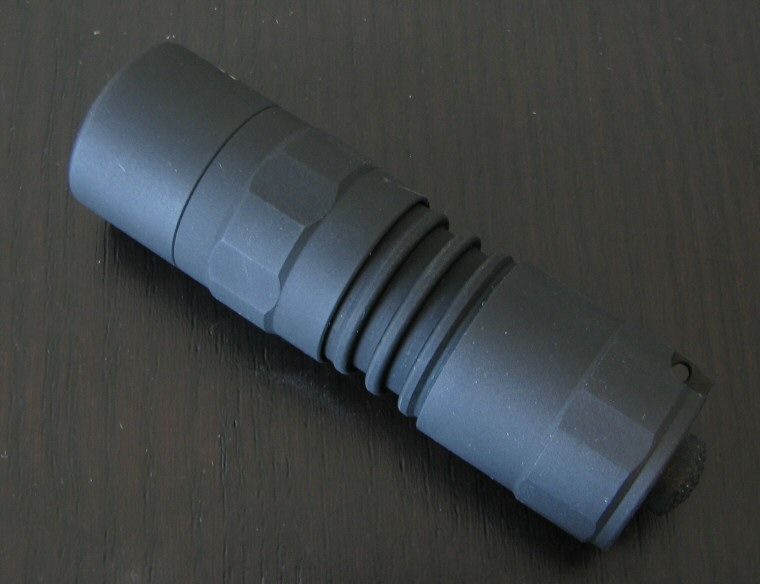
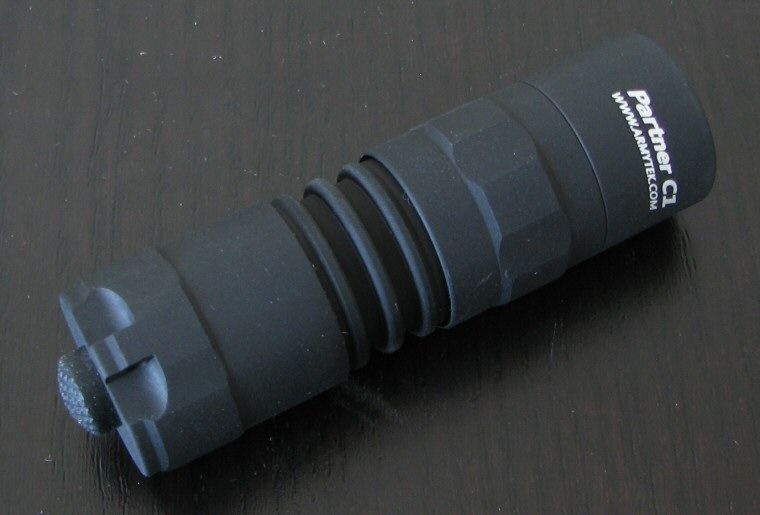
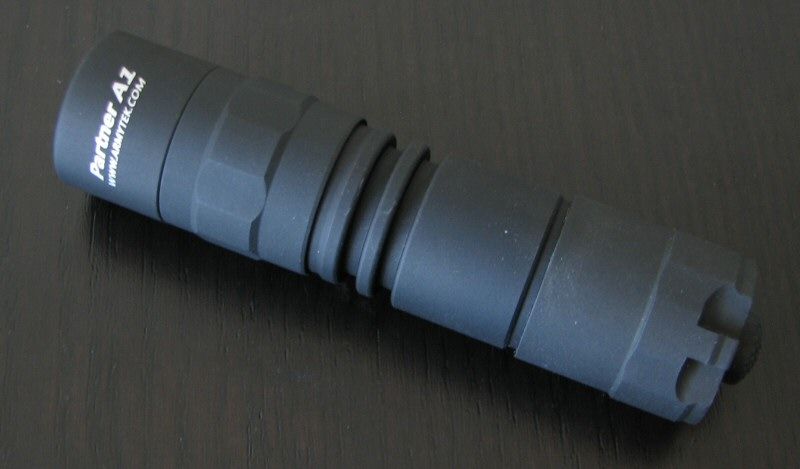
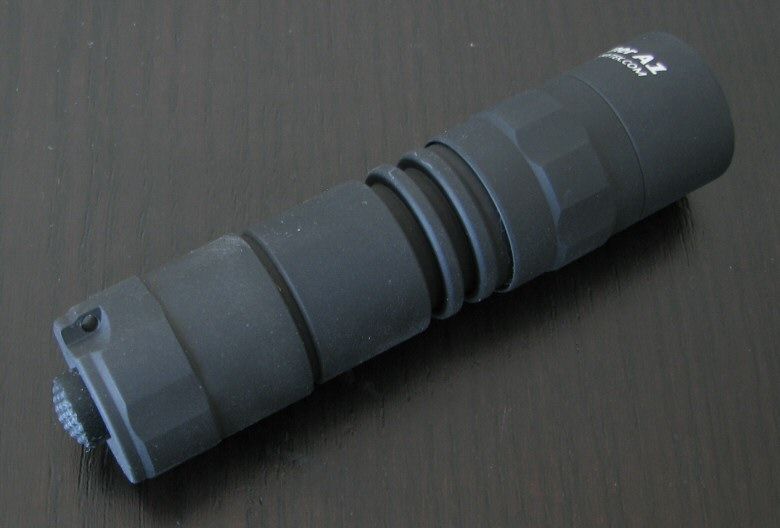
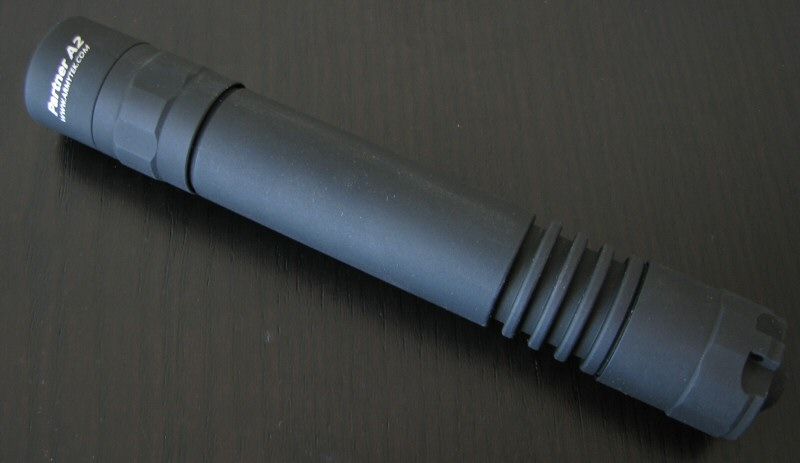
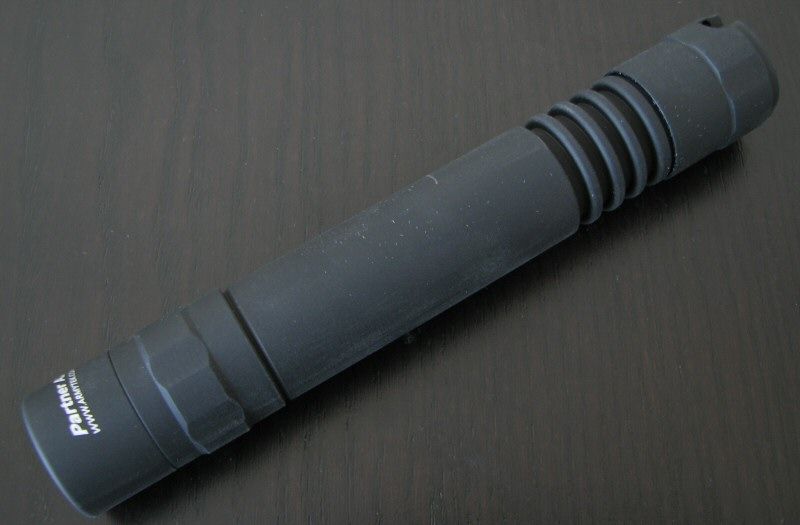
Given the complexity of reviewing so many lights at one time, I have broken up this review into common elements up top (i.e., general build, user interface, etc.), and have left the specific comparisons (size overviews, beamshots, runtimes, etc.) in separate sections at the end, for each of the three battery-type models.
For most of this review, I have focused the light pics on the XP-G models, but have highlighted the XM-L versions where appropriate. There's a ton of data here, so sit back and make yourself comfortable …
Manufacturer Reported Specifications:
(note: I don't have space to get into each model in detail, so see ArmyTek's website for more info. Below is just a quick overview of the major features, taken from their website).
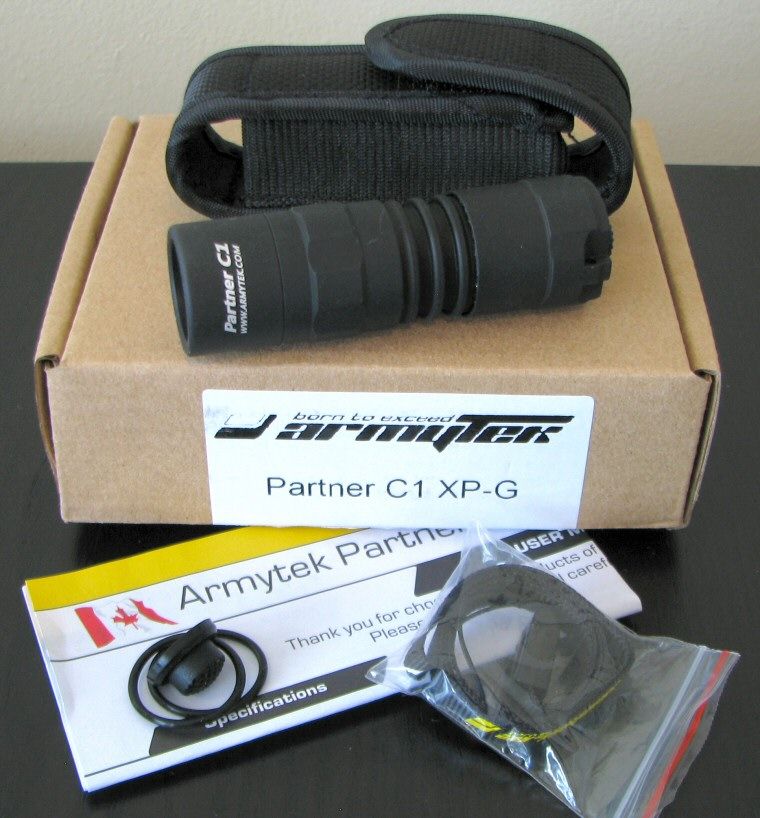
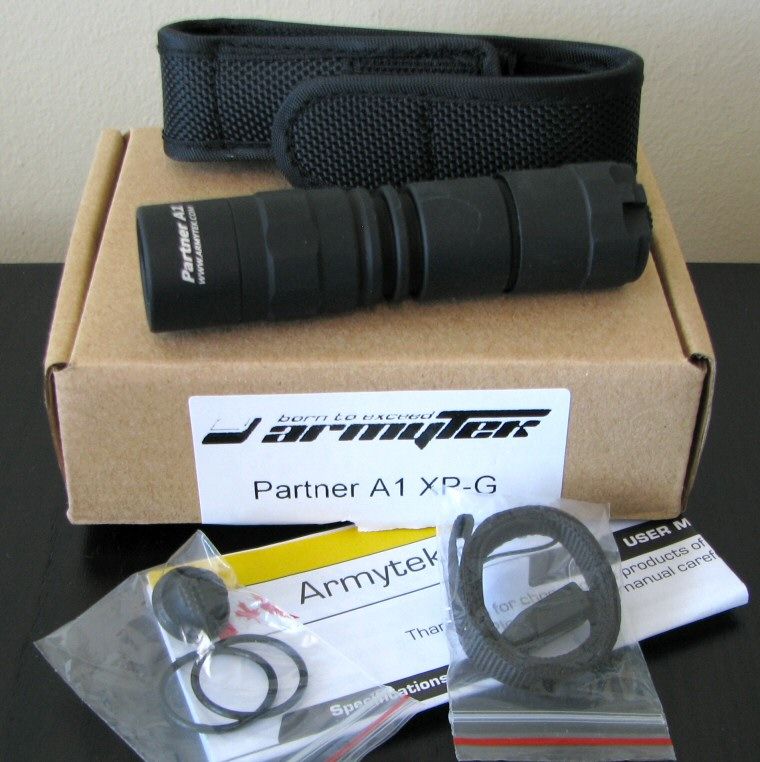
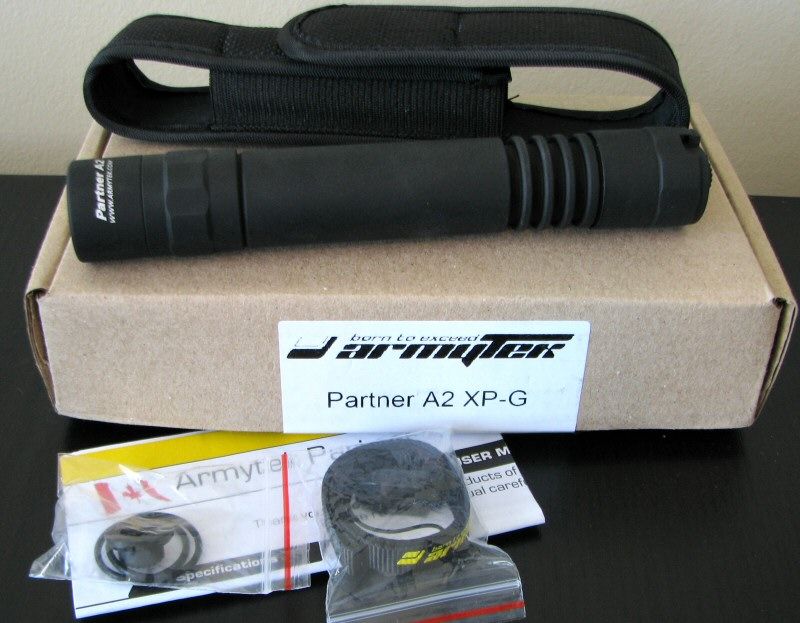
Packaging is common for all versions - a typical carboard box, reminiscent of the Zebralight lights. Inside, the light comes with a basic but good quality holster with closing flap, wrist lanyard, spare o-rings and boot cover, and manual.
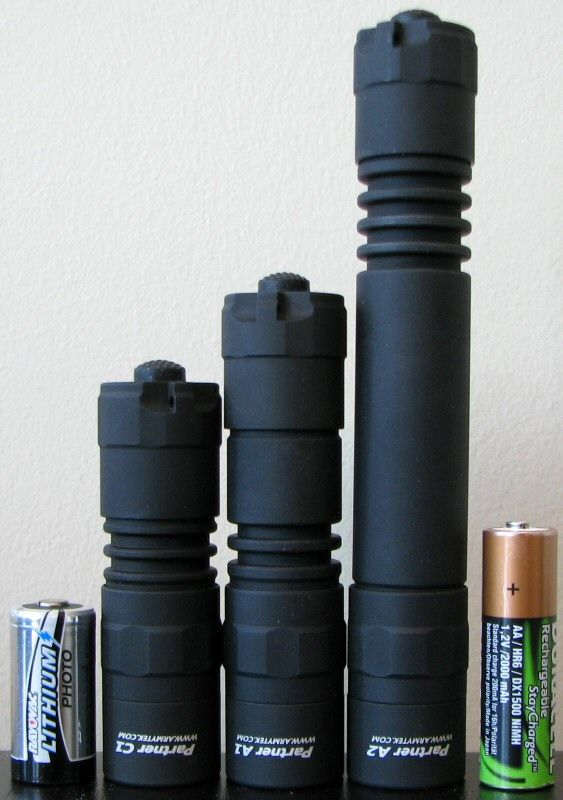
From left to right: Rayovac CR123A; ArmyTel Partner C1 XP-G, A1 XP-G, A2 XP-G, Duracell NiMH AA.
Detail comparisons for each model – relative to their respective class – will be provided later in this review.
Common Build Elements
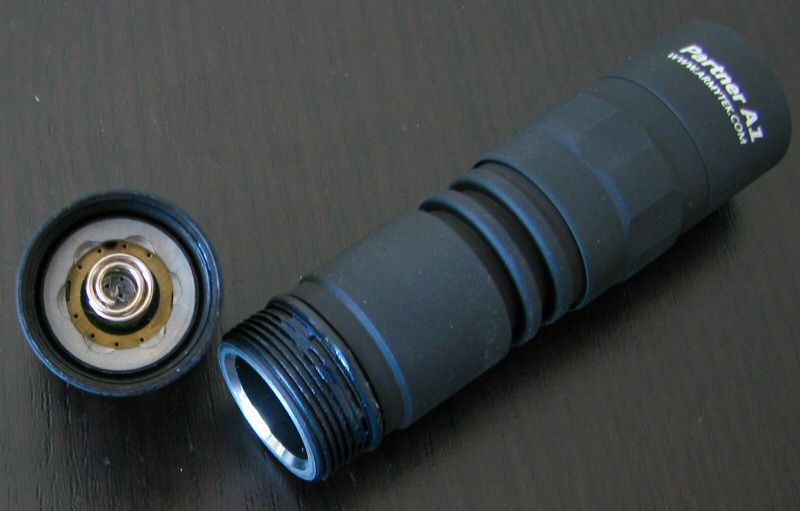
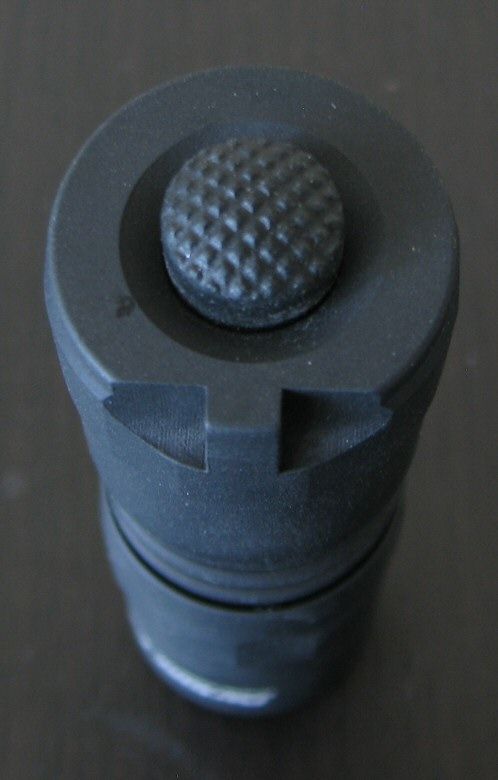
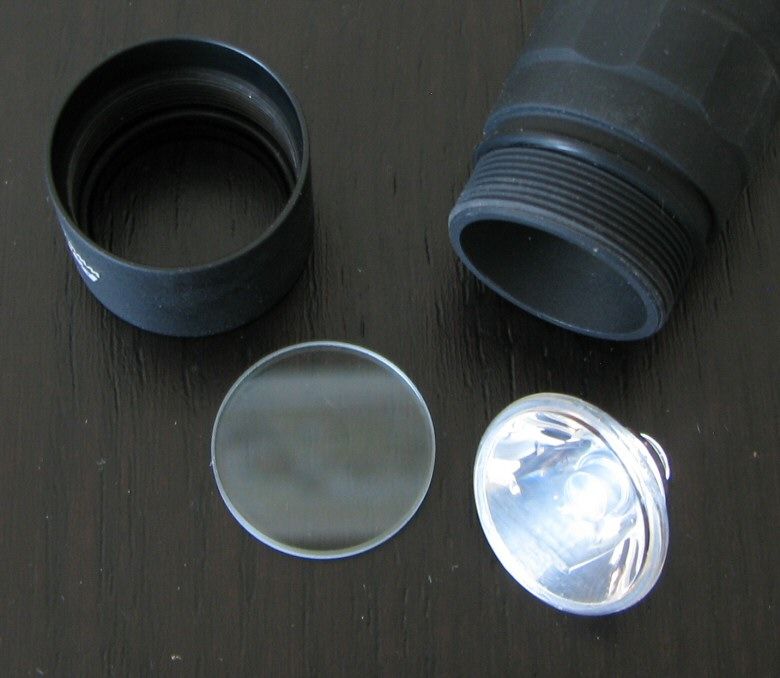
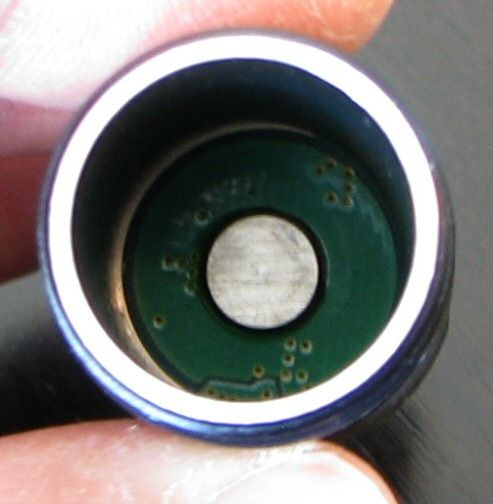
As always, ArmyTek build quality is very high, and the lights have a very robust feel. Physically, the two classes of models are distinguished primarily by their emitters and optics, which I will describe in more detail below.
The ArmyTek finish is fairly unique in my testing - the bodies of their lights have a very thick matte finish anodizing that feels almost molded (i.e., it is very "grippy"). According to ArmyTek, this anodization coating is much thicker than most lights. Although the lights lack knurling, grip is actually quite decent thanks to this unique finish. And there are some ridge detail elements to help further with grip.
Note the grippier finish may show dirt, hand oil, etc, more easily than traditional glossy knurling. There are also no real anti-roll features (except for some flattened areas of the tailcap), so the lights can all roll easily. Lettering is very bright and clear, and very legible.
Screw threads are standard triangular cut, but seem of good quality. Screw threads are anodized at the tail region of the battery tube and in the tailcap (for lock-out). Edges of the battery tube have all been chamfered (i.e., rounded off), which shows a nice attention to detail.
The tailcap switch is a reverse clicky in all lights, with good feel. The spring is thicker and longer than typical on these sorts of lights, with a flattened end (so as not to scratch your batteries).
There is a lanyard attachment point at the base of the tailcap. The lights cannot tailstand.
There is a small raised contact point in the head, so high capacity flat-top batteries can be used.
As mentioned earlier, the lights are distinguished by their emitter and optic choice. Note that the lights do not use a reflector, but have a customized TIR optic that goes with each emitter type.
XP-G emitter:
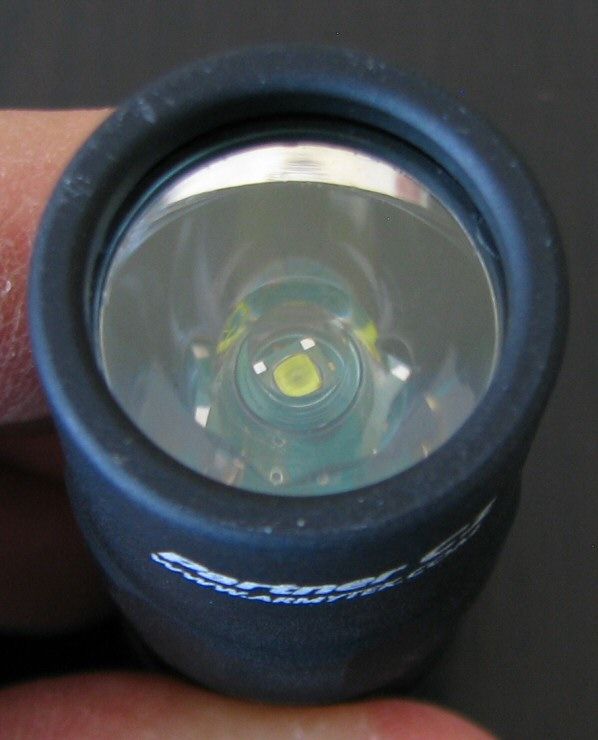
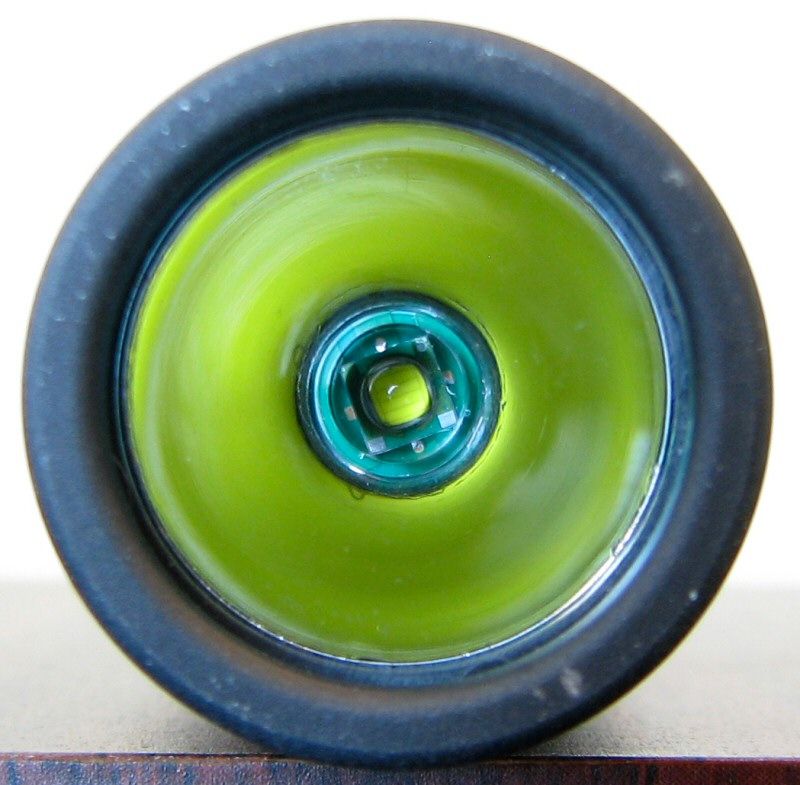
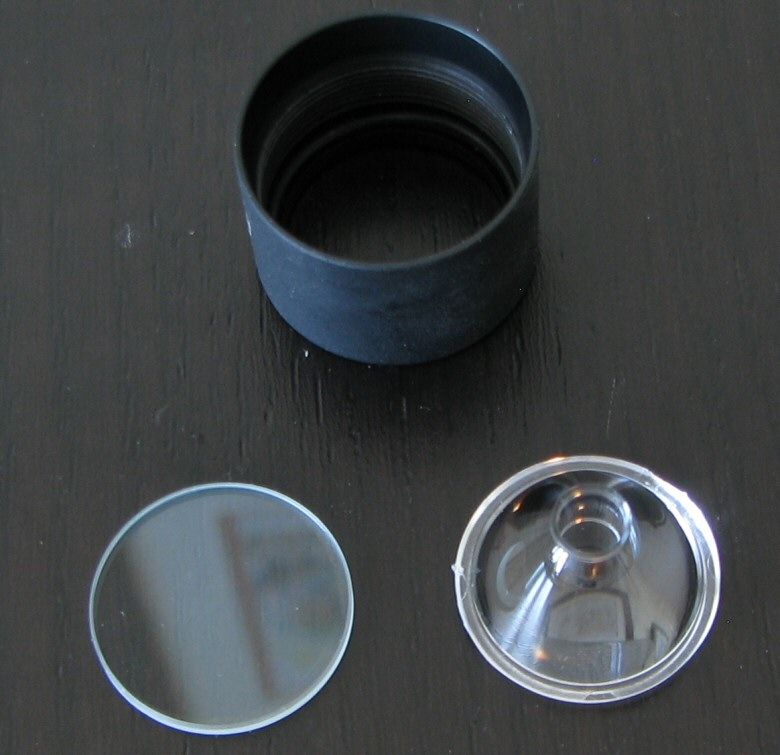
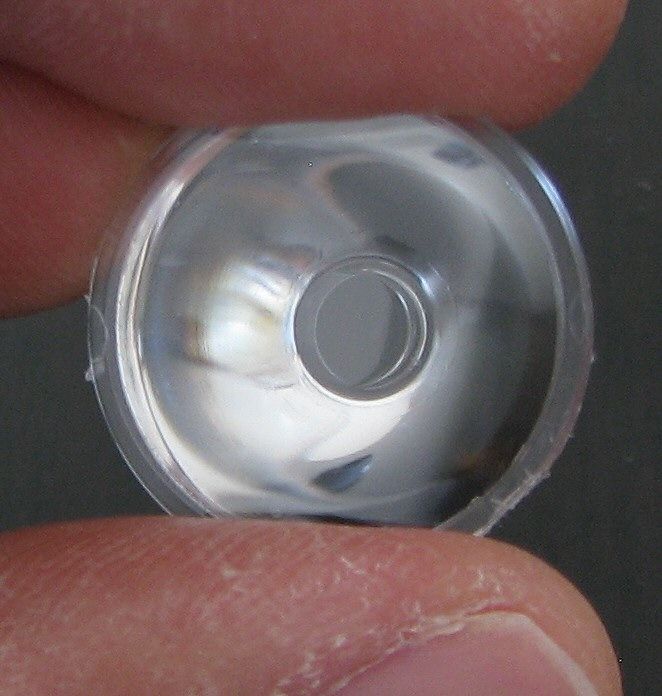
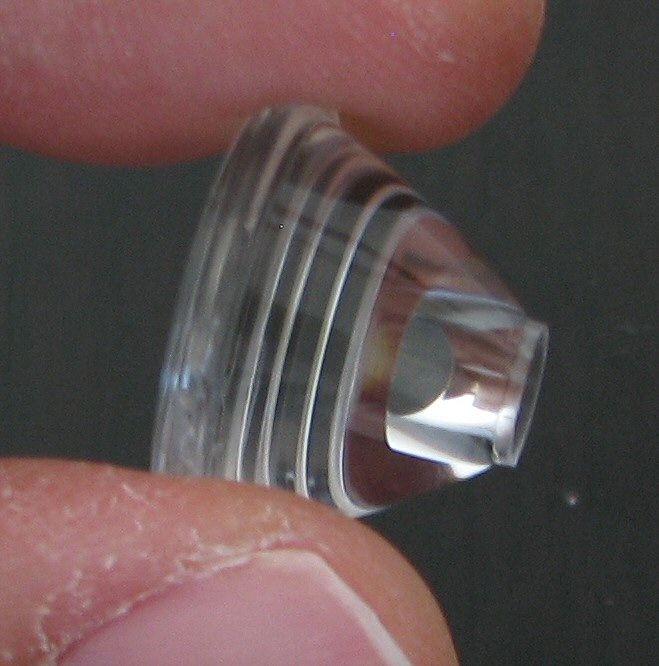
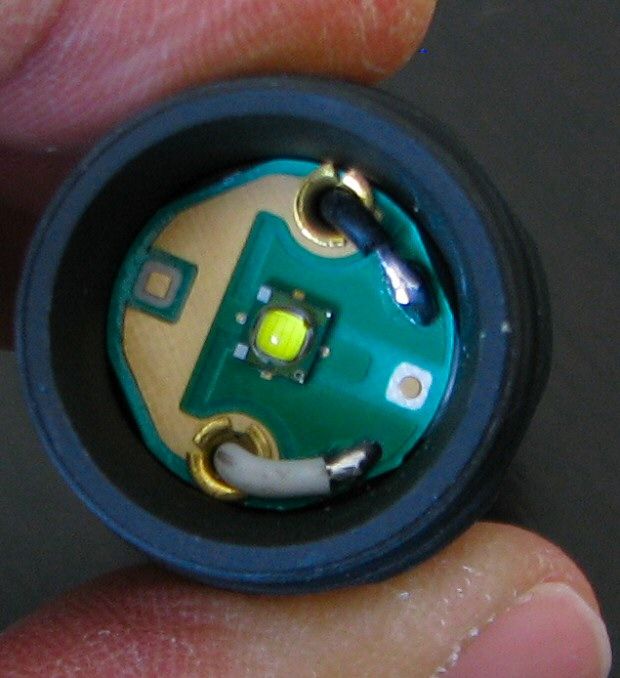
XM-L emitter:
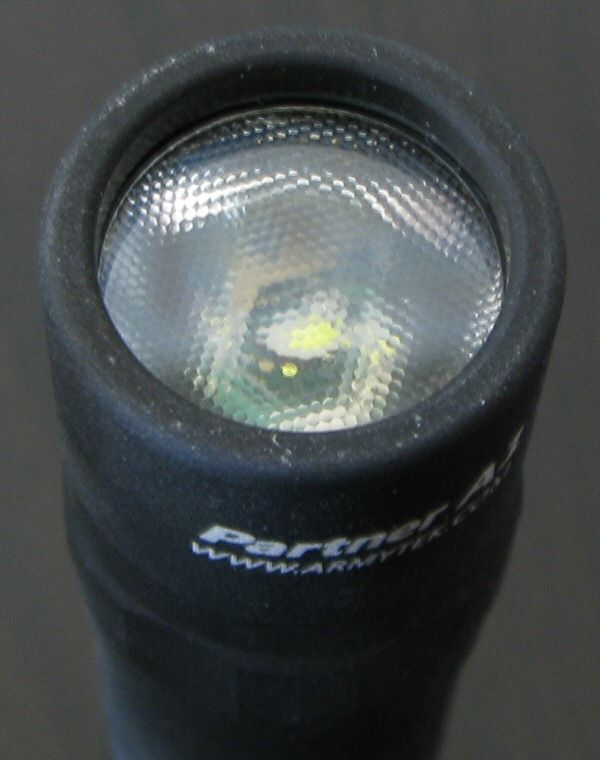
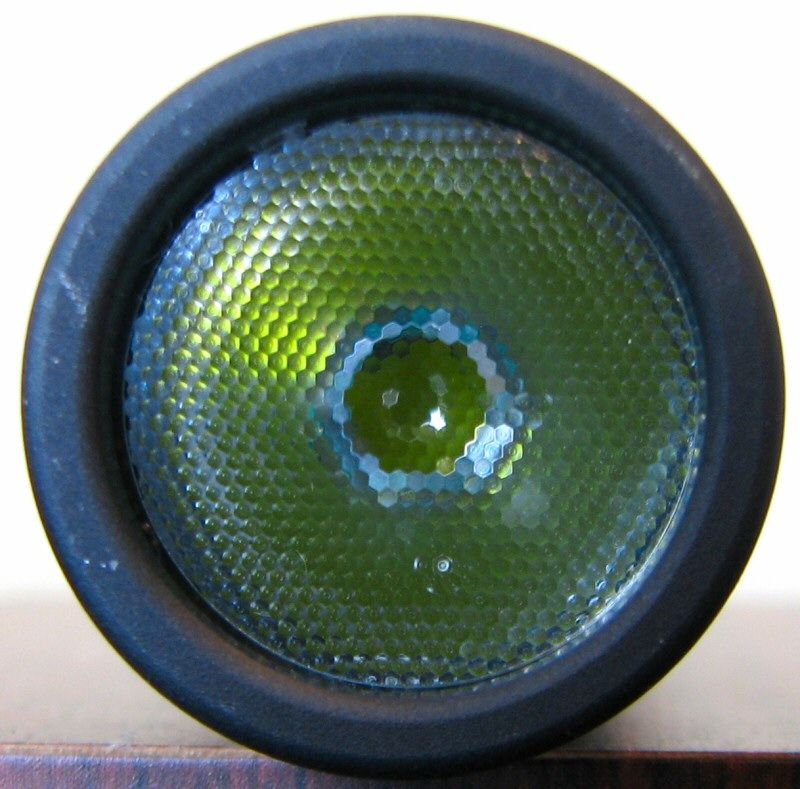
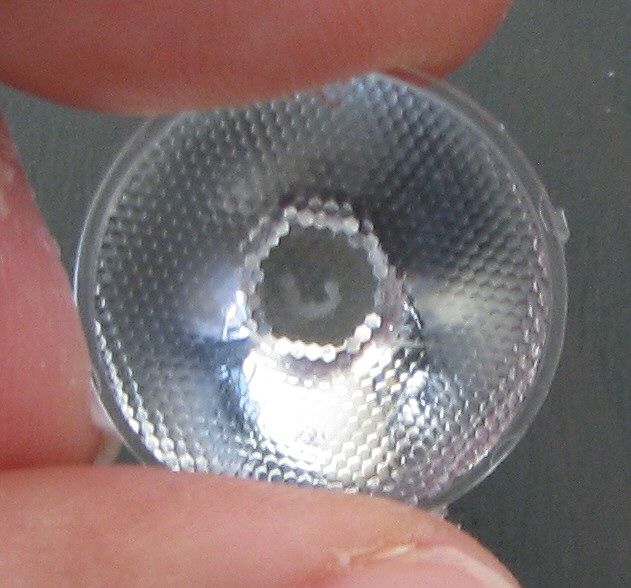
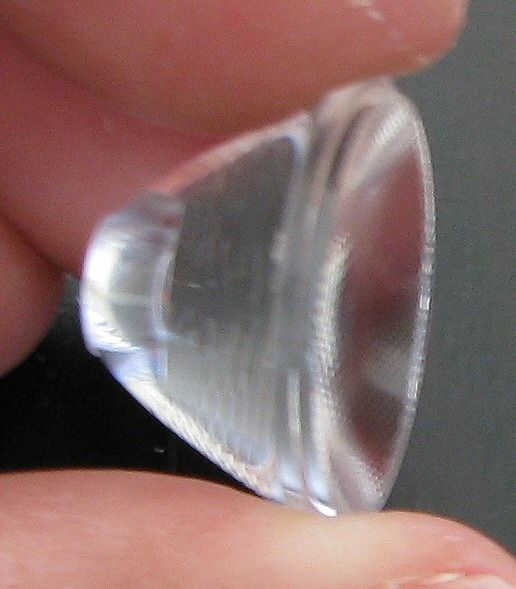
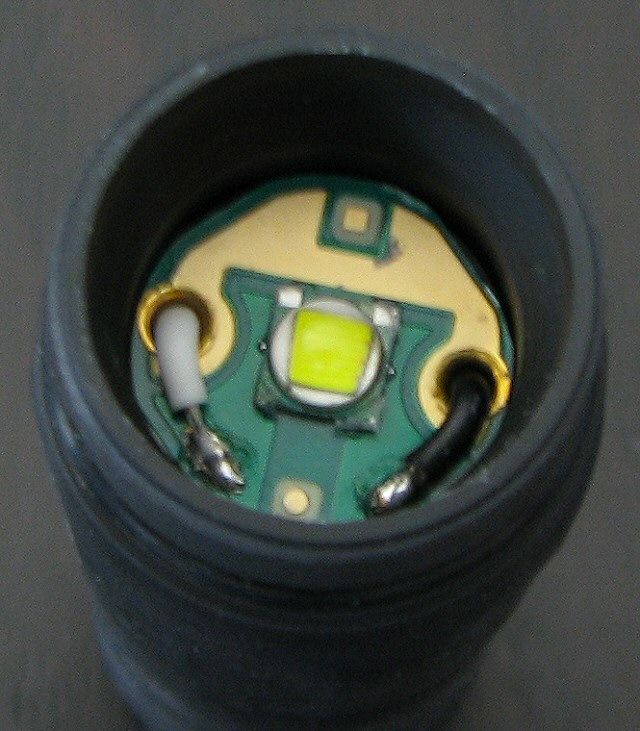
In all cases, the head of the light has a flat aluminum bezel. Use of TIR optics means the spill will be reduced (compared to reflectored lights). Although hard to capture on camera, please see my detailed beamshots later in this review, for each model.
User Interface
The Partner interface is very basic. The lights use a reverse clicky tailcap – press and release (click) to turn on.
The lights have two modes, Lo and Hi, accessed in sequence (i.e., click off-on to switch modes). When the light hasn't been used in awhile, it always comes on in Lo.
But there is an unusual twist here – when changing between modes, most lights only retain the last setting for a couple of seconds (i.e., you have to click off-on quickly to advance modes). But In the Partner case, mode-switching memory is retained for 7 mins. This means it will advance to the next mode if you turn the light off and back on within 7 mins.
There are no "blinky" modes on the Partners.
UPDATE AUGUST 14, 2013:ArmyTek informs me that they plan to switch to a new circuit without this long mode-switching delay. They will also add a third mode (i.e., Max - Med - Lo), and will include a clip on the next batch of lights.
Video:
For information on the light, including the build and user interface, please see my video overview:
Video was recorded in 720p, but YouTube typically defaults to 360p. Once the video is running, you can click on the configuration settings icon and select the higher 480p to 720p options. You can also run full-screen.
As with all my videos, I recommend you have annotations turned on. I commonly update the commentary with additional information or clarifications before publicly releasing the video.
PWM
There is no sign of PWM at either output level, on any light – the Partners are all current-controlled.
Testing Method:
All my output numbers are relative for my home-made light box setup, a la Quickbeam's flashlightreviews.com method. You can directly compare all my relative output values from different reviews - i.e. an output value of "10" in one graph is the same as "10" in another. All runtimes are done under a cooling fan, except for any extended run Lo/Min modes (i.e. >12 hours) which are done without cooling.
I have devised a method for converting my lightbox relative output values (ROV) to estimated Lumens. See my How to convert Selfbuilt's Lightbox values to Lumens thread for more info.
Throw/Output Summary Chart:
My summary tables are reported in a manner consistent with the ANSI FL-1 standard for flashlight testing. Please see http://www.flashlightreviews.ca/FL1.htm for a discussion, and a description of all the terms used in these tables. Effective July 2012, I have updated all my Peak Intensity/Beam Distance measures with a NIST-certified Extech EA31 lightmeter (orange highlights).
Ok, now that the common elements are out of the way, let's move on to the detailed testing of each battery-type model. :sweat:
------------
Partner C1
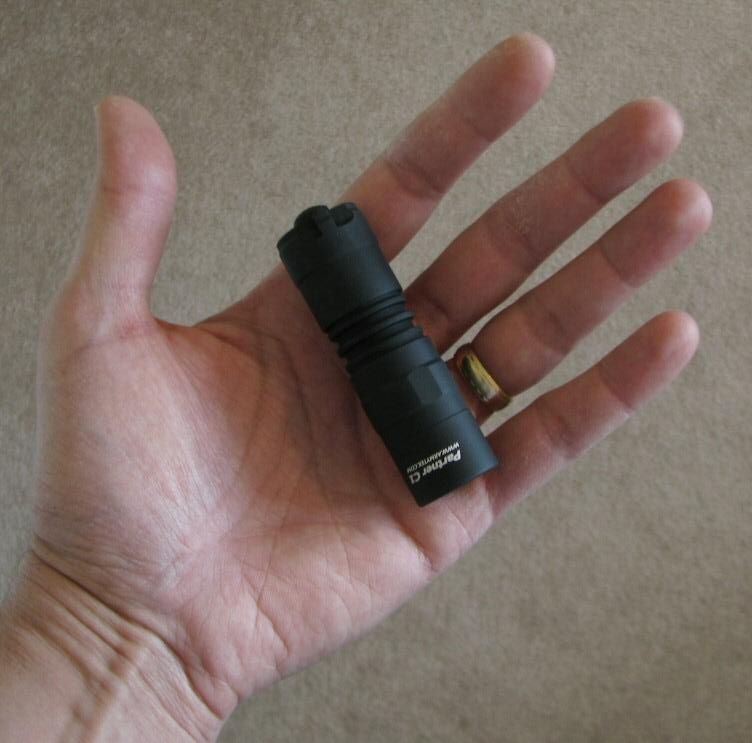
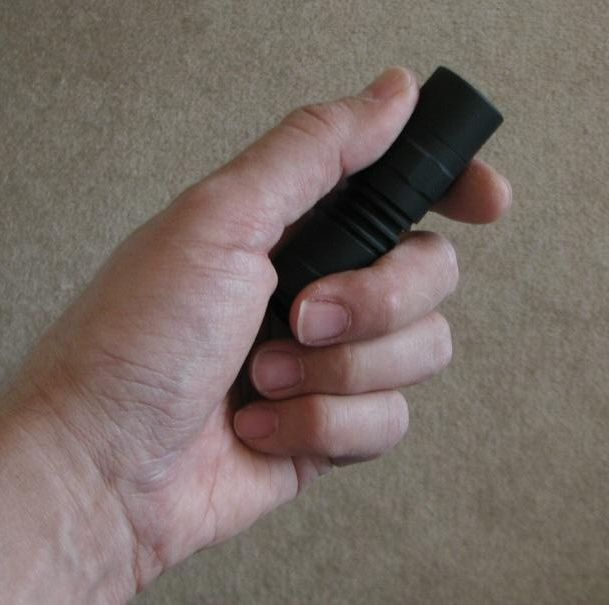
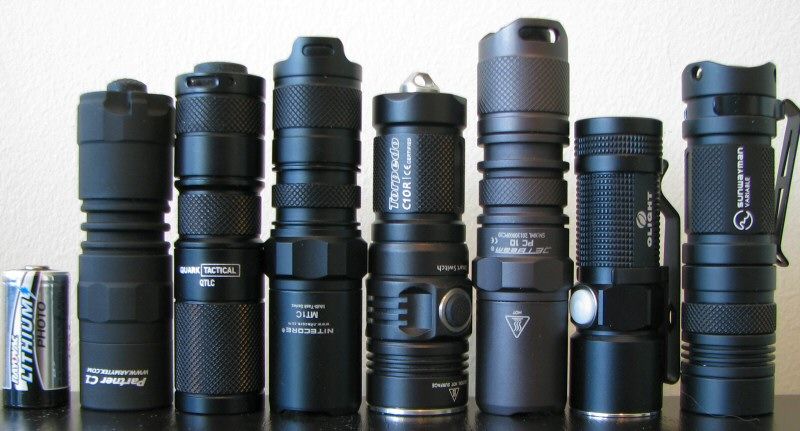
From left to right: Rayovac CR123A; ArmyTek Partner C1 XP-G; Foursevens QTLC; Nitecore MT1C; Sunwayman C10Rl JetBeam PC10; Olight S10; Sunwayman V11R.
All dimensions directly measured, and given with no batteries installed:
1xCR123A/RCR:
ArmyTek C1 XP-G: Weight: 42.6g, Length: 79.8mm , With (bezel): 23.1mm
ArmyTek C1 XM-L: Weight: 43.0g, Length: 80.2mm , With (bezel): 23.1mm
Lumintop ED11: Weight: 44.1g, Length: 83.7, Width (bezel): 21.8mm
Foursevens QTLC: Weight 36.4g, Length 84.1mm, Width (bezel) 22.1mm
Olight S10: Weight 41.1g, Length: 70.6mm, Width (bezel): 23.0mm
Sunwayman C10R: Weight: 57.3g, Length: 76.2mm (no lanyard plug), 82.3mm (with plug), Width (bezel): 25.6mm, Width (head at widest part): 28.6mm
Eagletac D25C Clicky: Weight: 30g, Length: 76.0mm, Width (bezel): 20.0mm
Jetbeam PC10: Weight: 50.5g, Length: 93.6mm, Width (bezel): 22.6mm
Beamshots:
For white-wall beamshots below, all lights are on Max output on an AW protected 18650 battery. Lights are about ~0.75 meter from a white wall (with the camera ~1.25 meters back from the wall). Automatic white balance on the camera, to minimize tint differences.
Note: the XP-G Partner versions are not labeled with the emitter in the beamshots below. But to help you differentiate, all the XM-L versions are specifically identified.
1xCR123A
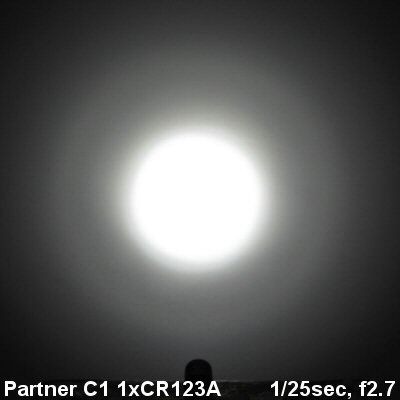
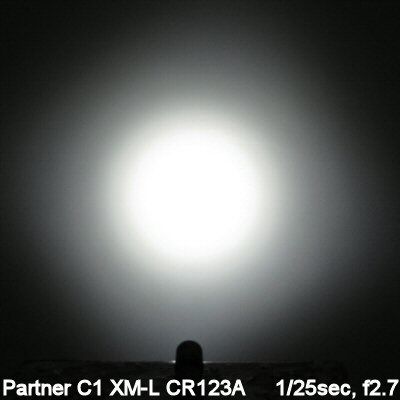
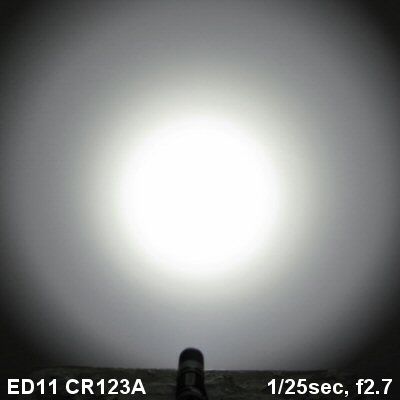
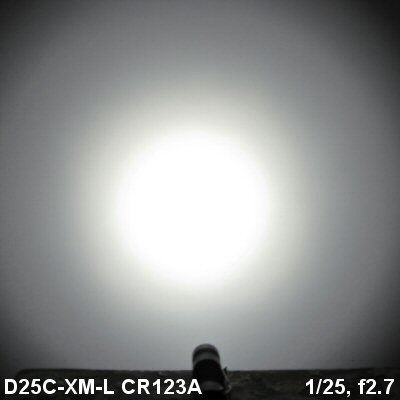
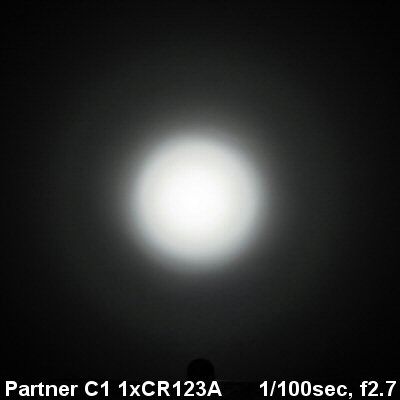
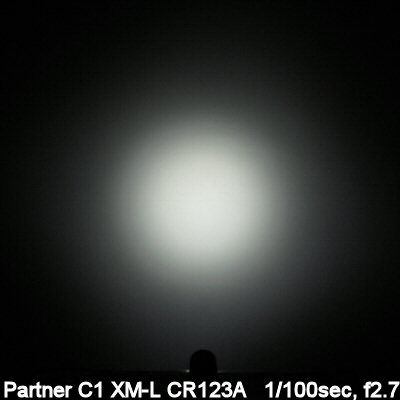
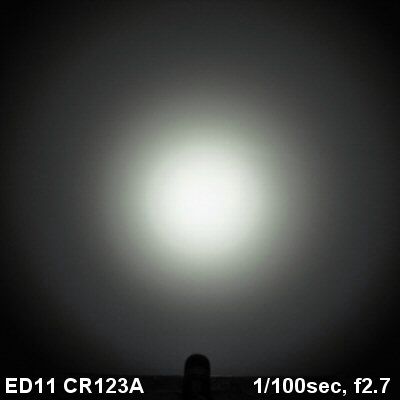
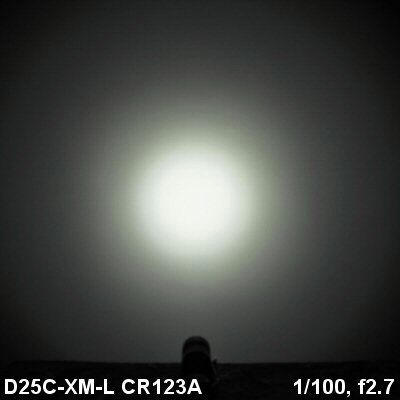
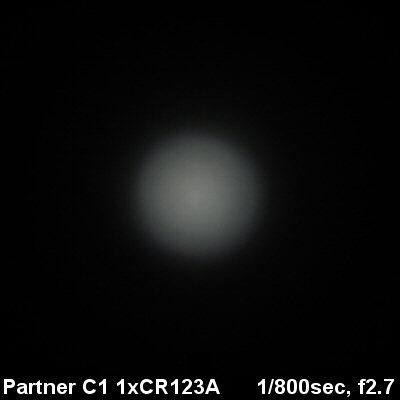
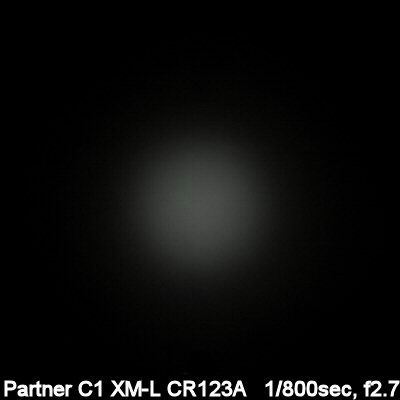
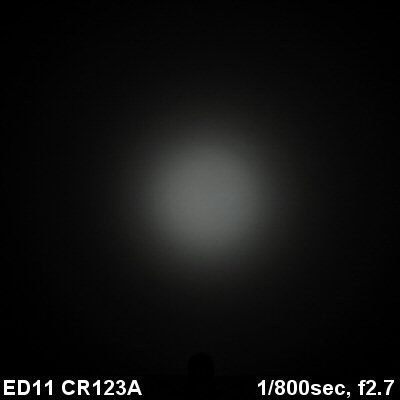
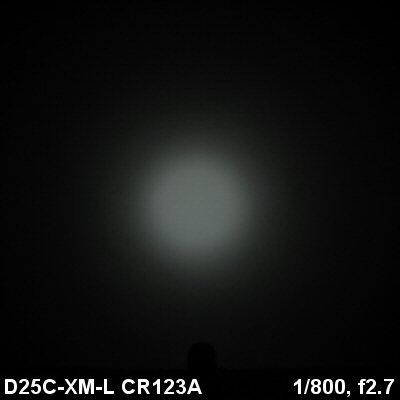
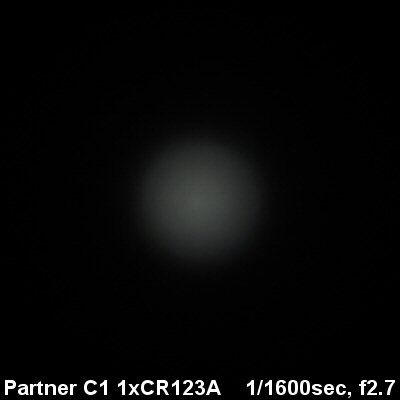
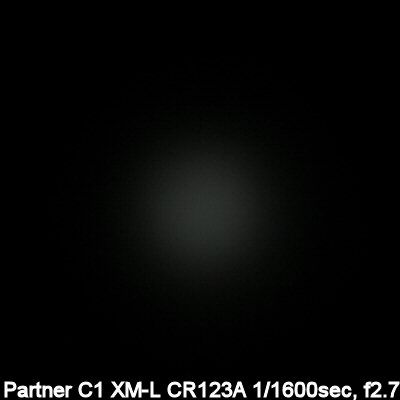
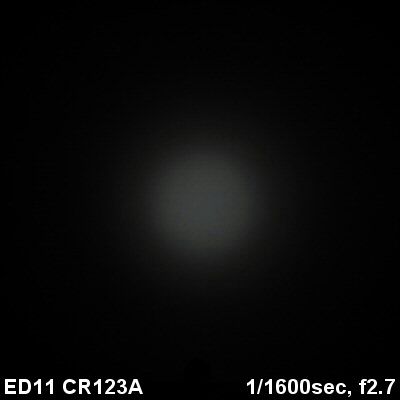
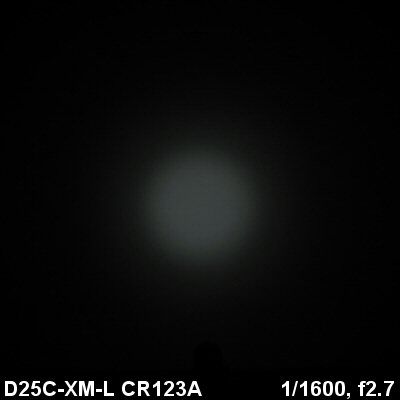
1xRCR
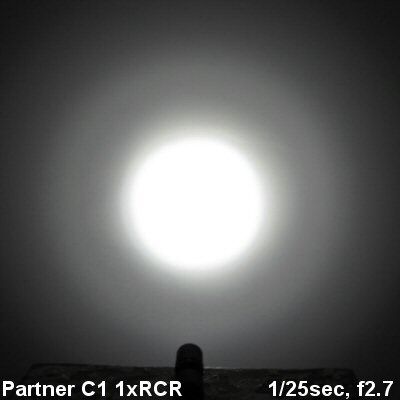
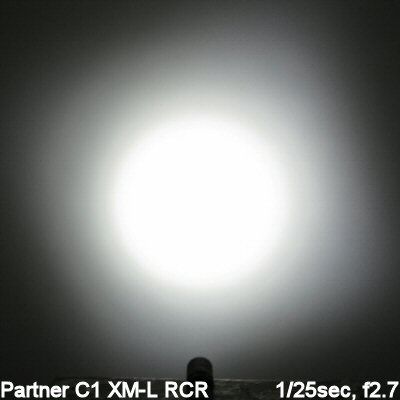
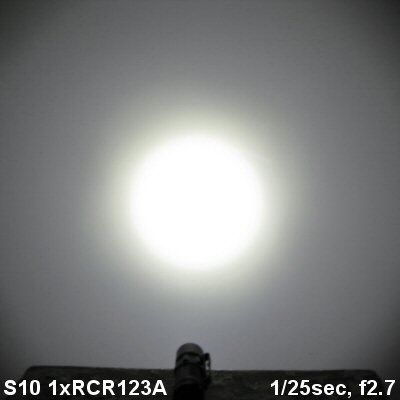
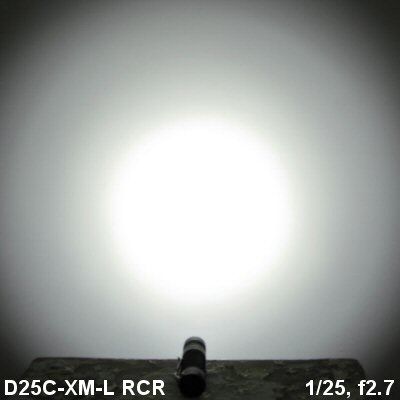
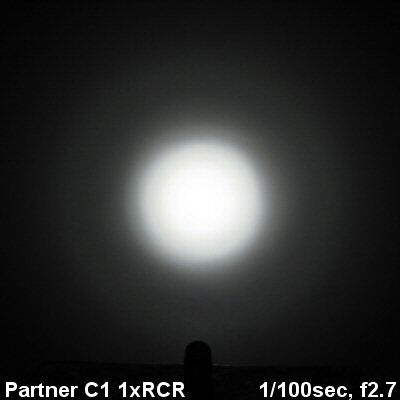
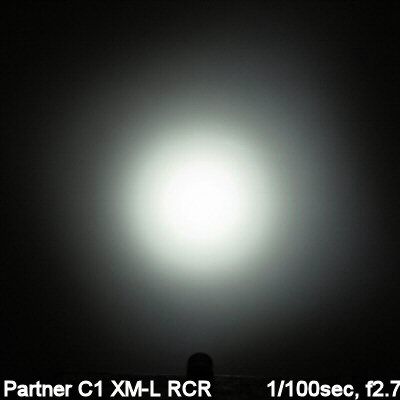
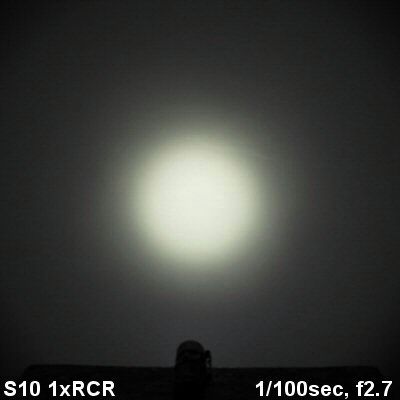
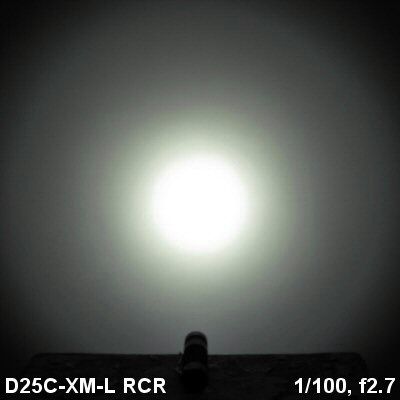
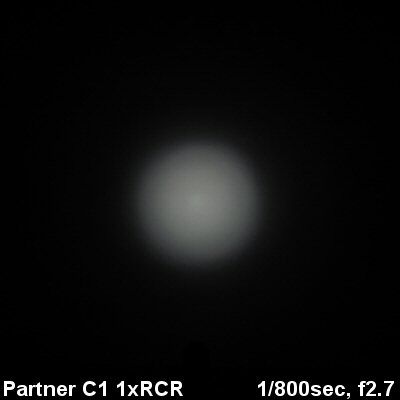
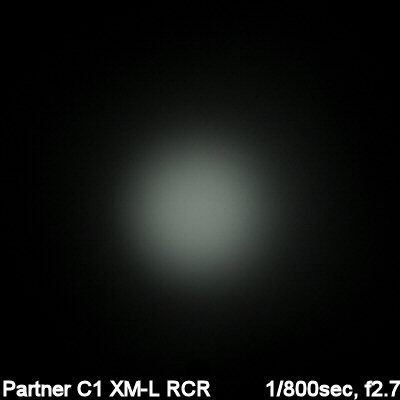
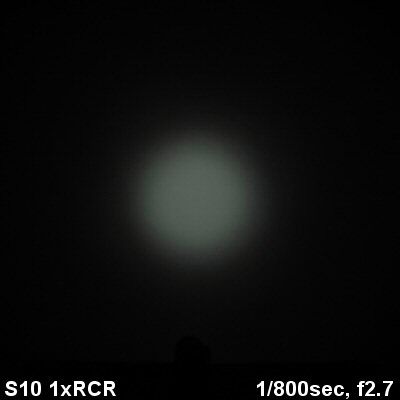
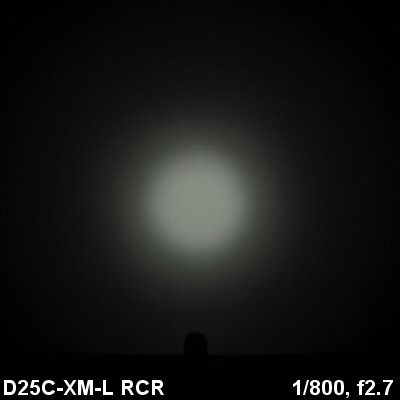
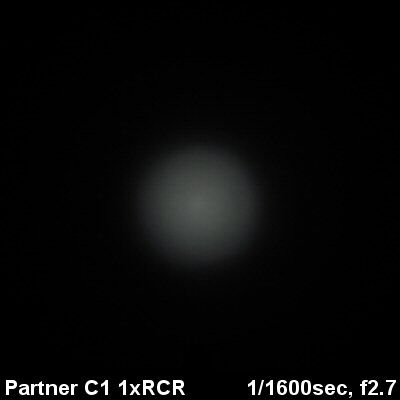
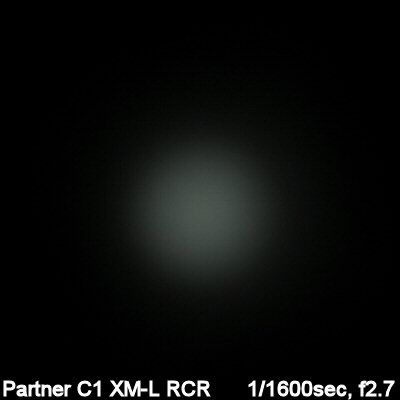
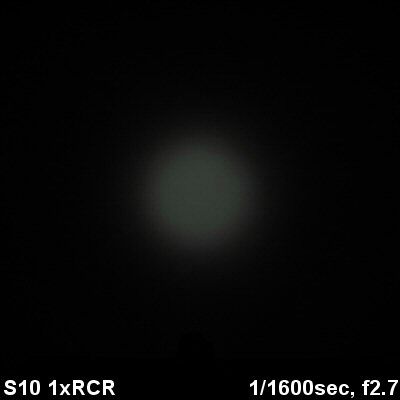
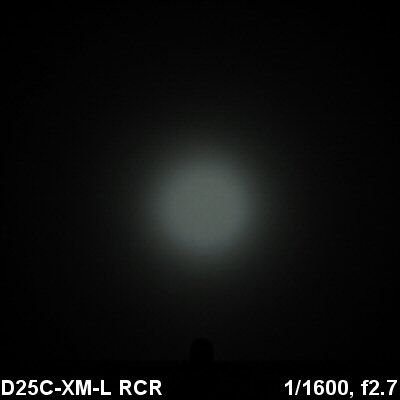
Summary Tables
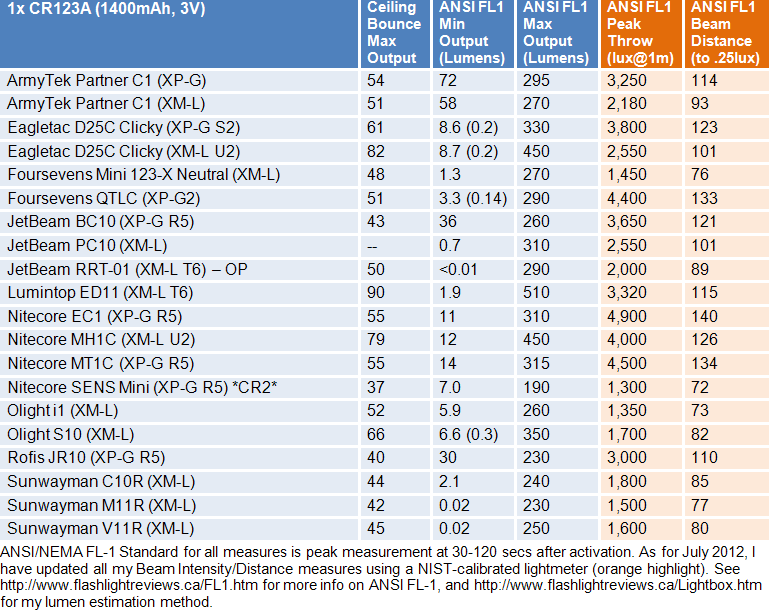
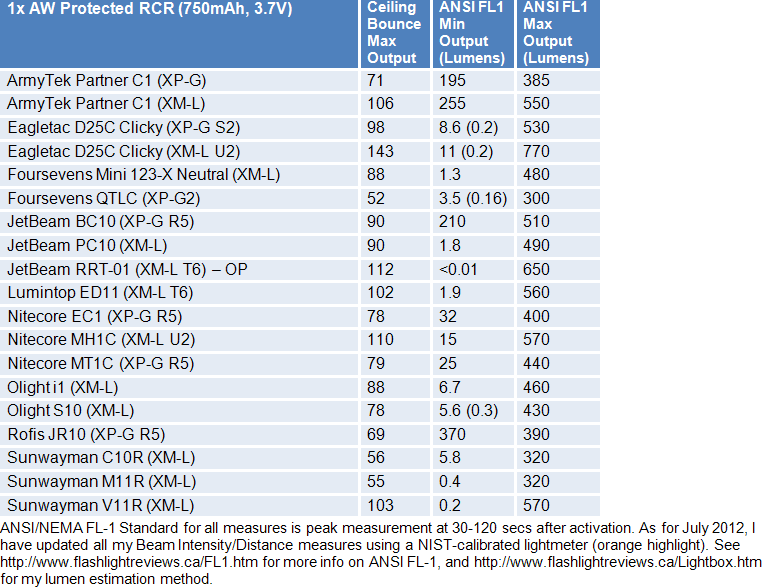
Runtimes
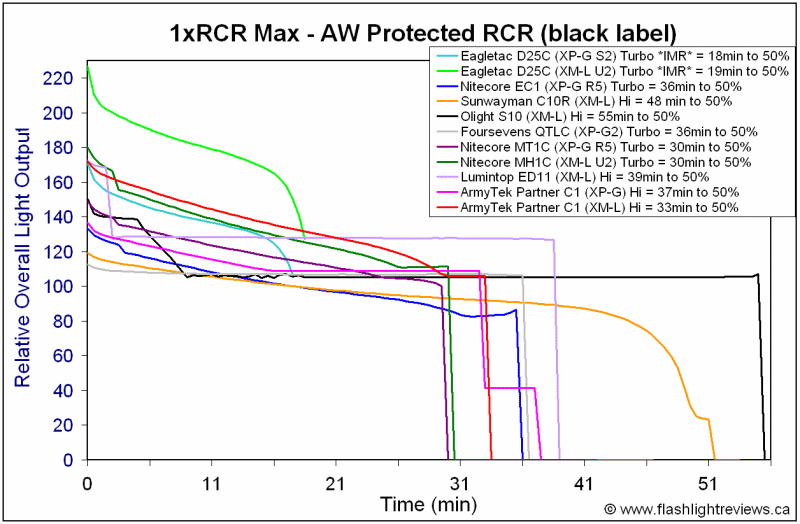
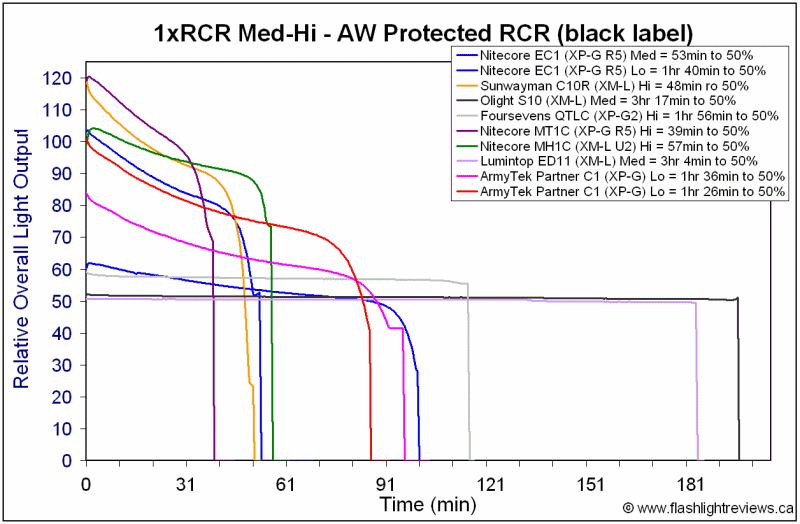
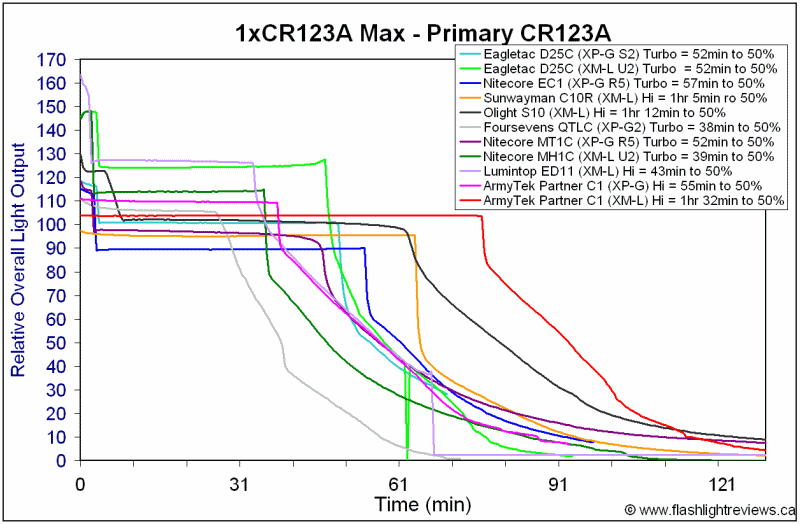
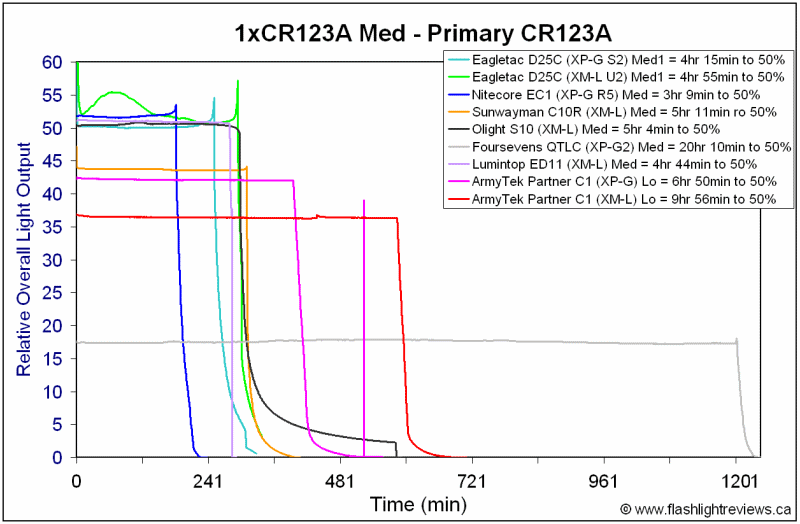
------------
Partner A1
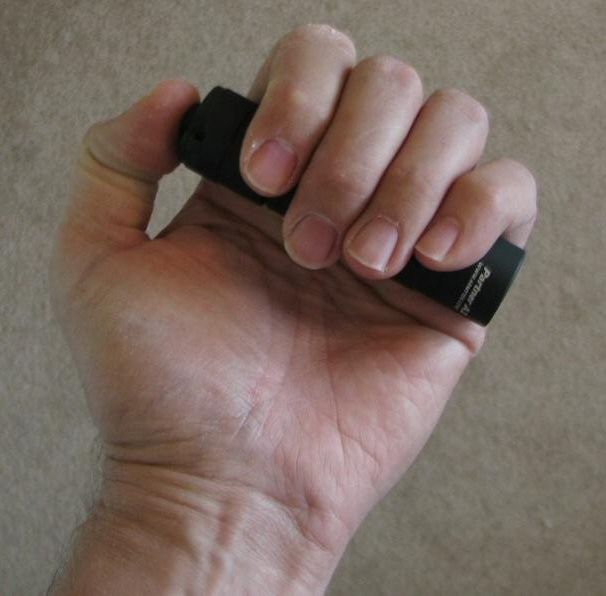
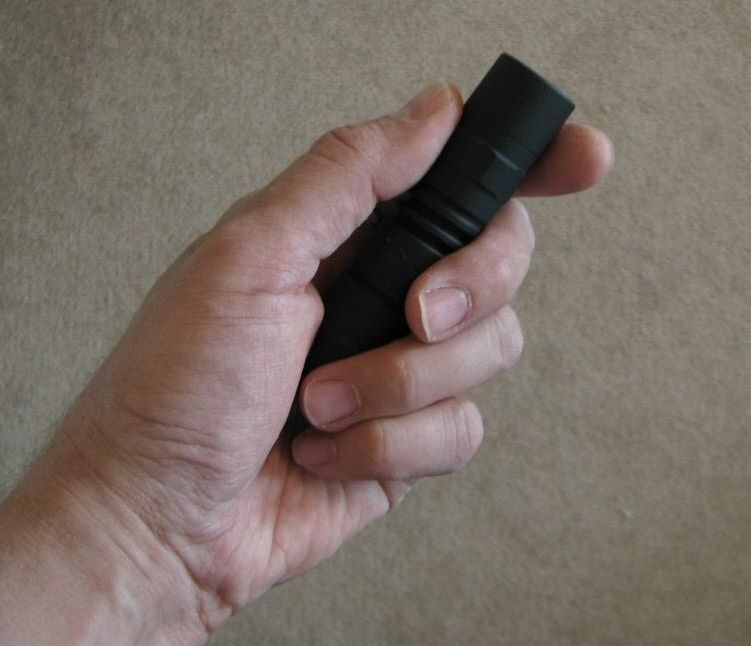
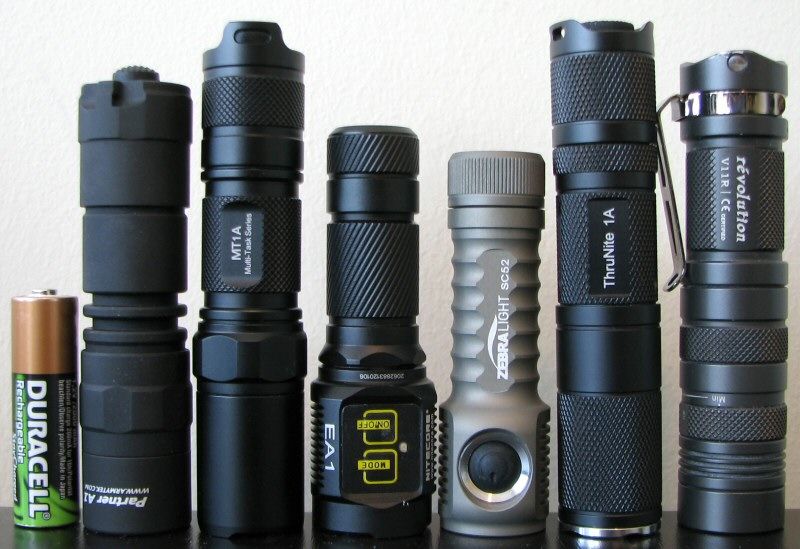
From left to right: Duracell NiMH AA; ArmyTek Partner A1 XP-G; Nitecore MT1A, EA1; Zebralight SC52; Thrunite Neutron 1A; Sunwayman V11R+AA extender.
All dimensions directly measured, and given with no batteries installed:
1xAA:
ArmyTek A1 XP-G: Weight: 57.3g, Length: 96.8mm , With (bezel): 23.1mm
ArmyTek A1 XM-L: Weight: 56.5g, Length: 97.2mm , With (bezel): 23.1mm
Olight S15 1xAA: Weight: 46.4g, Length: 87.0mm, Width (bezel): 23.1mm
Nitecore MT1A: Weight: 54.6g, Length: 104.6mm, Width (bezel): 22.7mm
Nitecore SENS AA: Weight: 26.1g, Length: 82.7mm, Width (bezel): 19.8mm
Lumintop ED15: Weight: 59.7g, Length: 100.2, Width (bezel): 21.9mm
Zebralight SC52: Weight 39.5g, Length 79.0mm, Width (bezel): 22.6mm, Width (max) 25.4mm
Rofis ER12: Wright: 35.5g, Length: 96.2mm, Width (bezel): 18.6mm
Xeno E03:: Weight: 48.1g, Length 96.7mm, Width (bezel): 21.5mm
Beamshots:
For white-wall beamshots below, all lights are on Max output on an AW protected 18650 battery. Lights are about ~0.75 meter from a white wall (with the camera ~1.25 meters back from the wall). Automatic white balance on the camera, to minimize tint differences.
Note: the XP-G Partner versions are not labeled with the emitter in the beamshots below. But to help you differentiate, all the XM-L versions are specifically identified.
1xAA Sanyo Eneloop NiMH
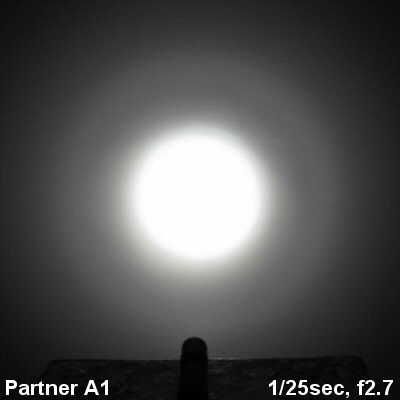
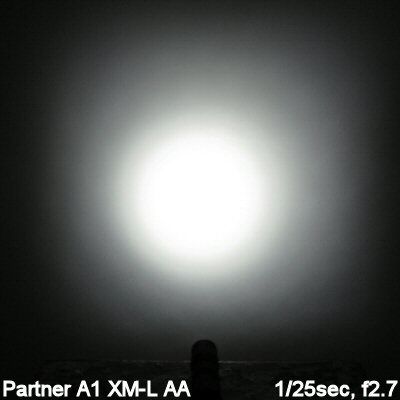
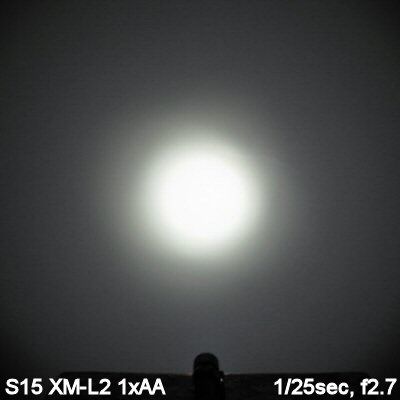
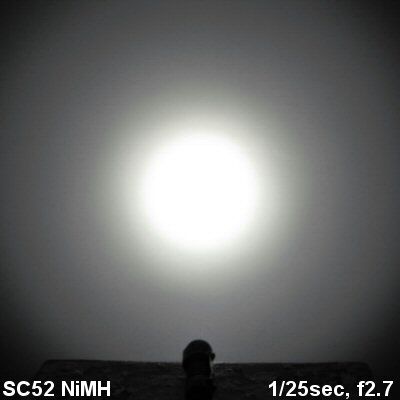
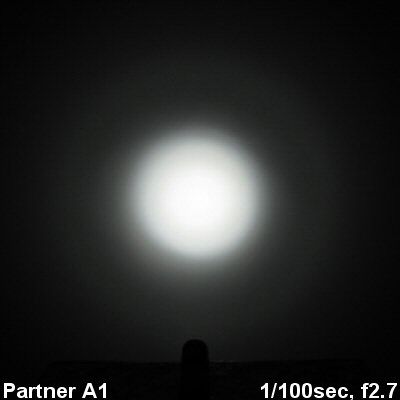
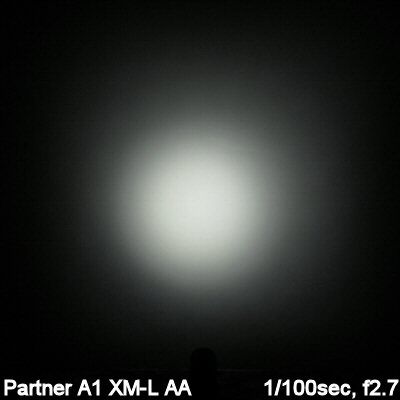
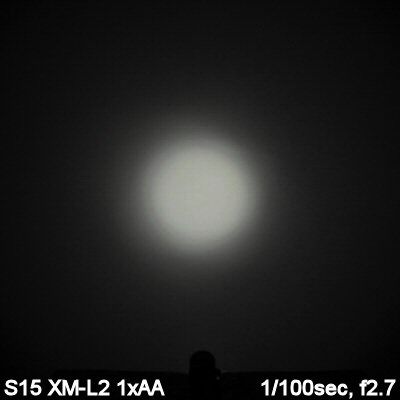
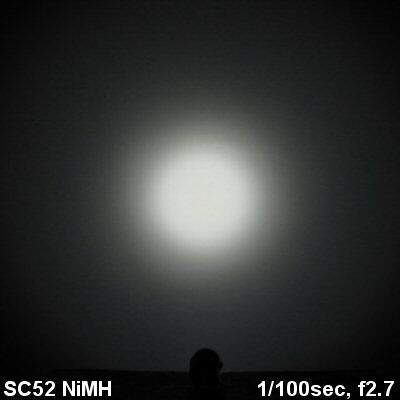
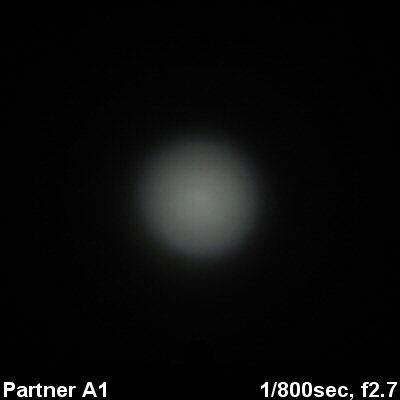
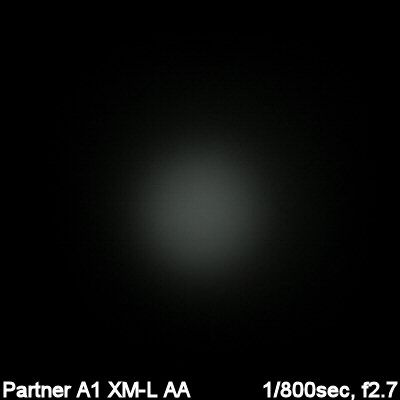
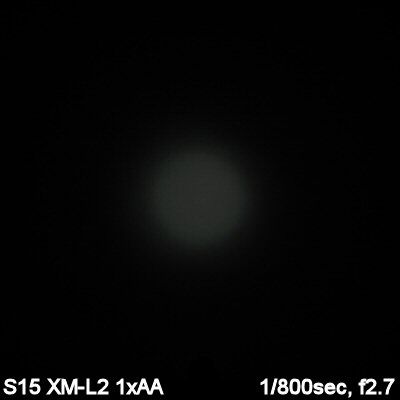
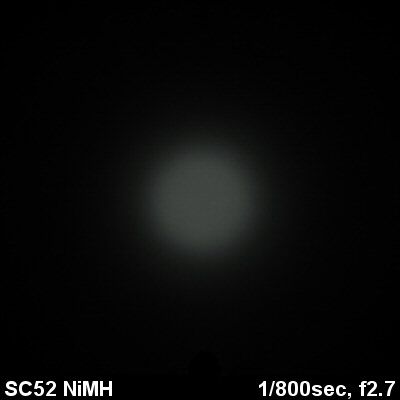
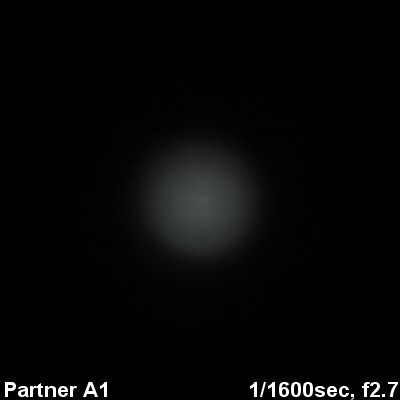
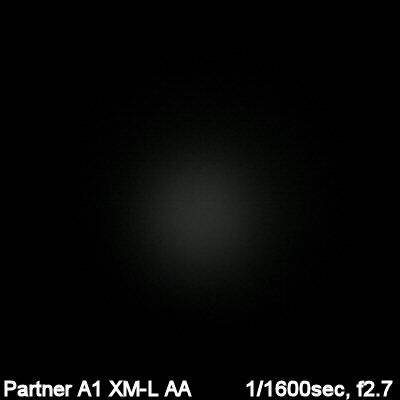

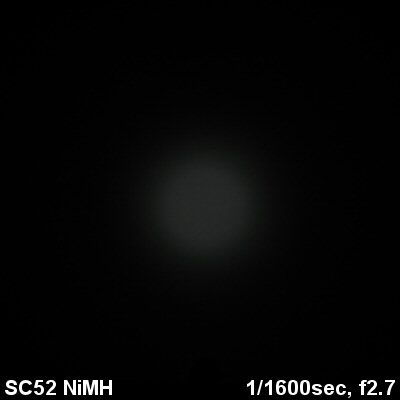
1x14500 (AW Protected 14500) Li-ion
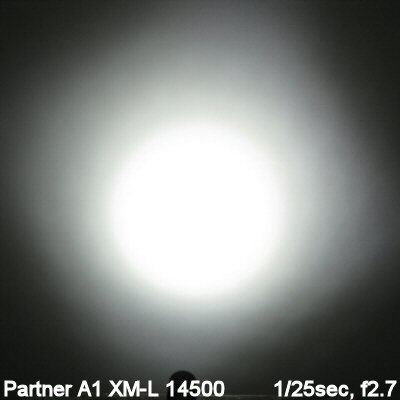
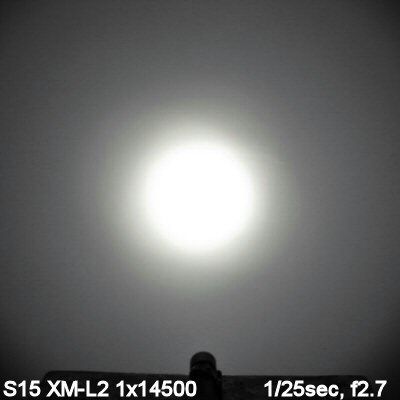
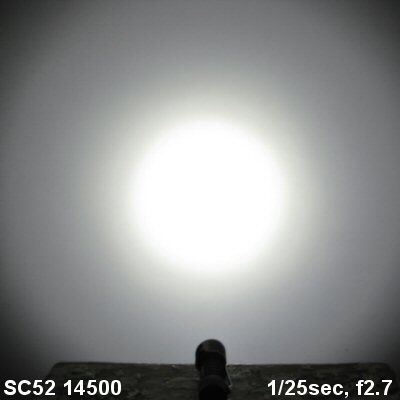
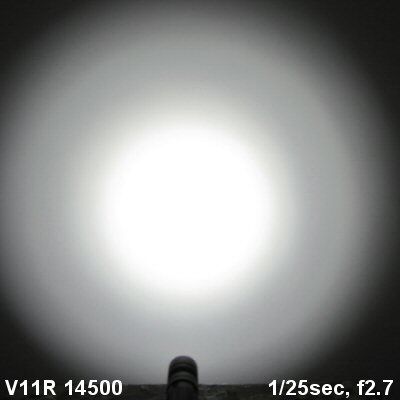
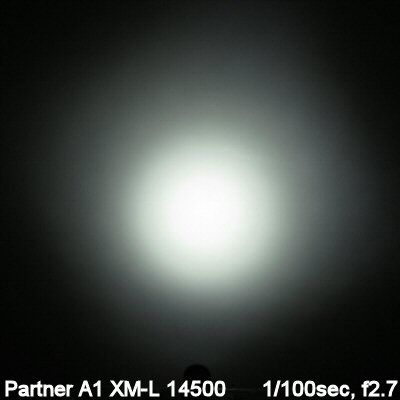
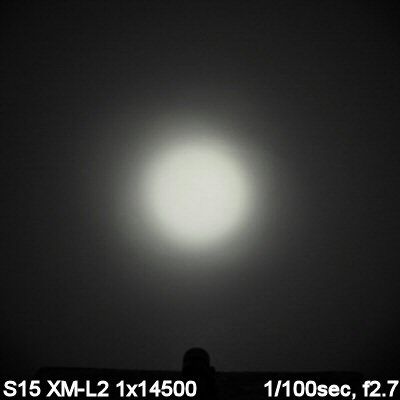
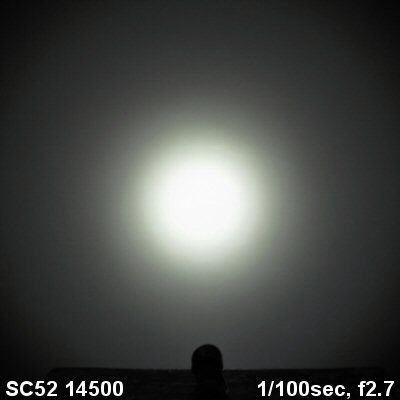
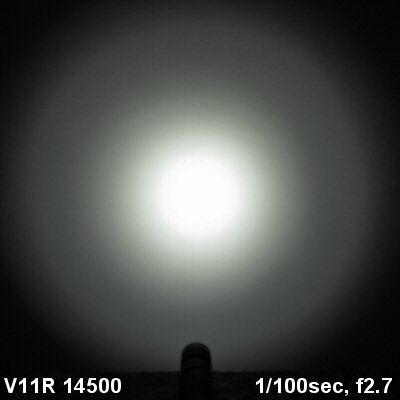
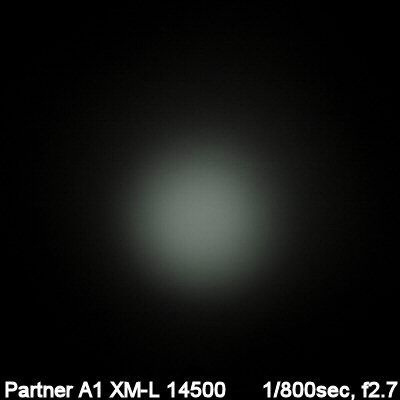
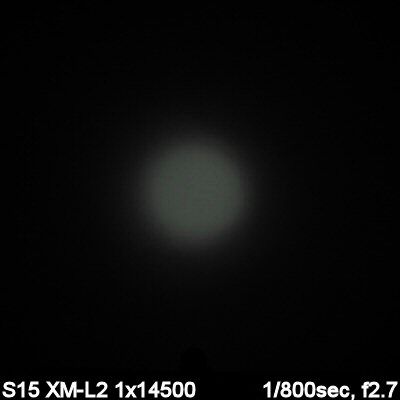
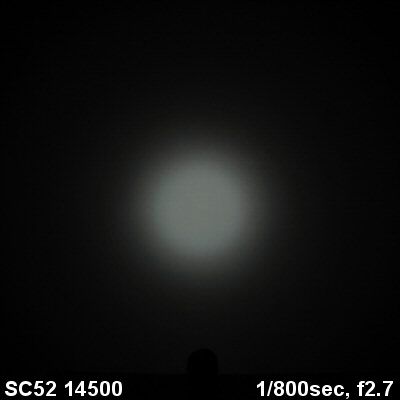
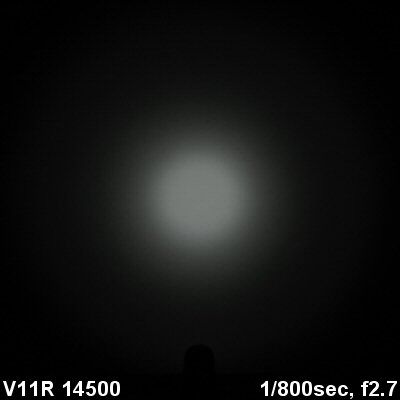
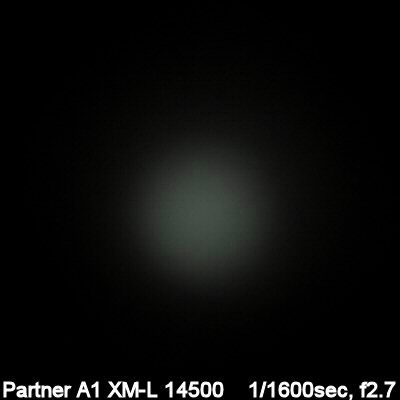
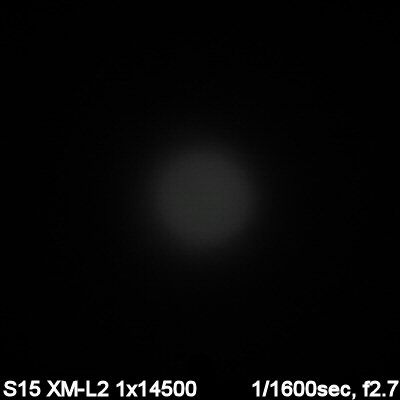
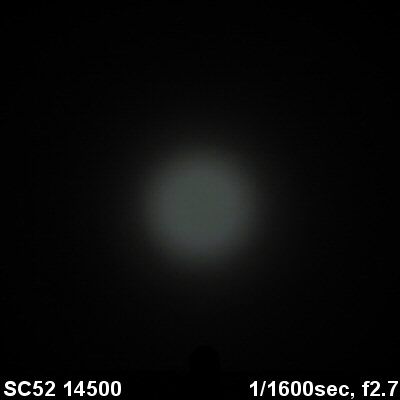
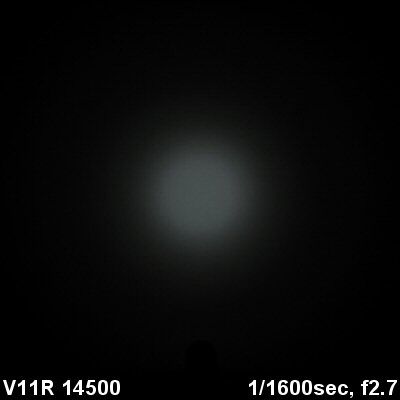
Summary Tables
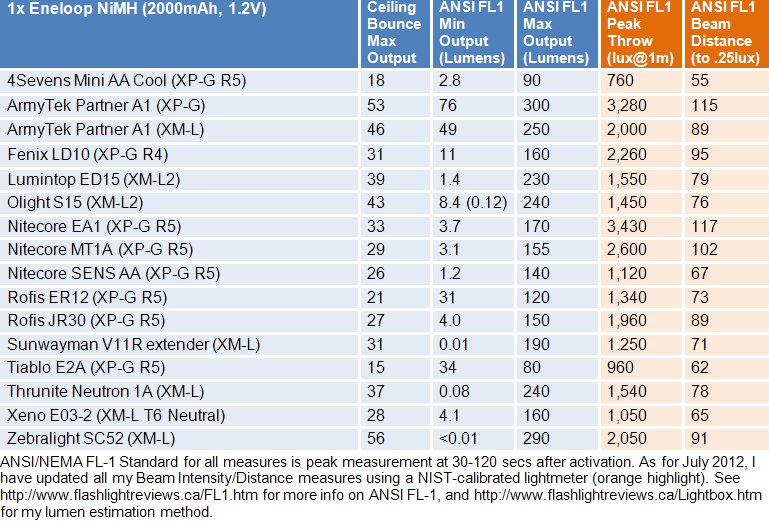
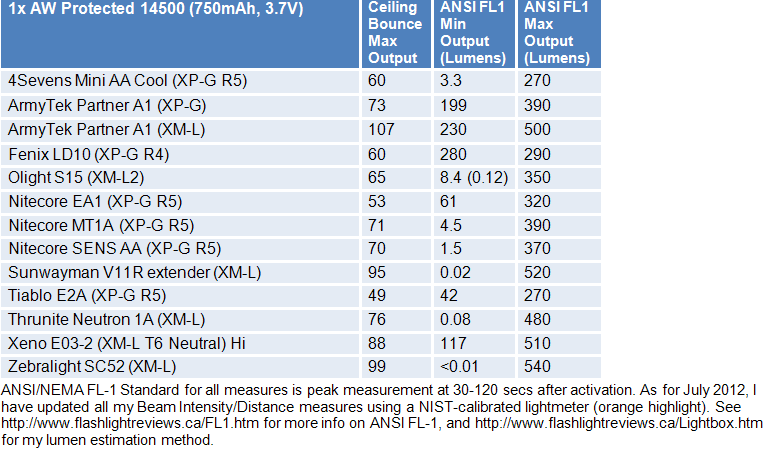
Runtimes
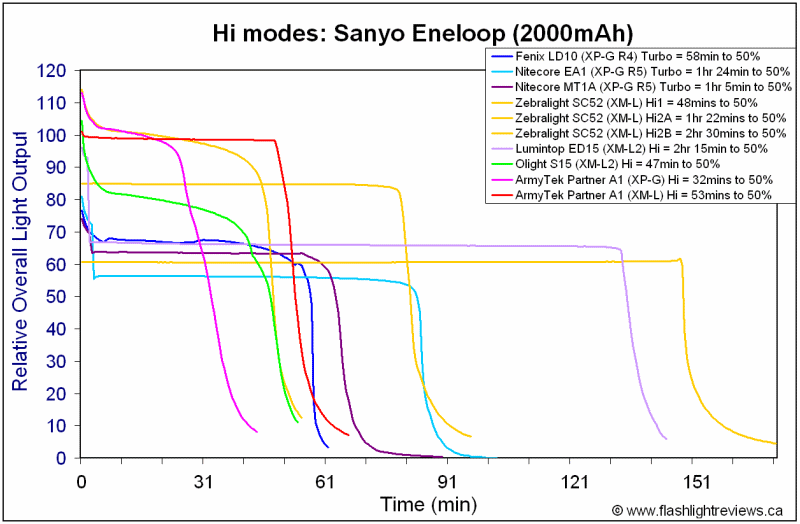
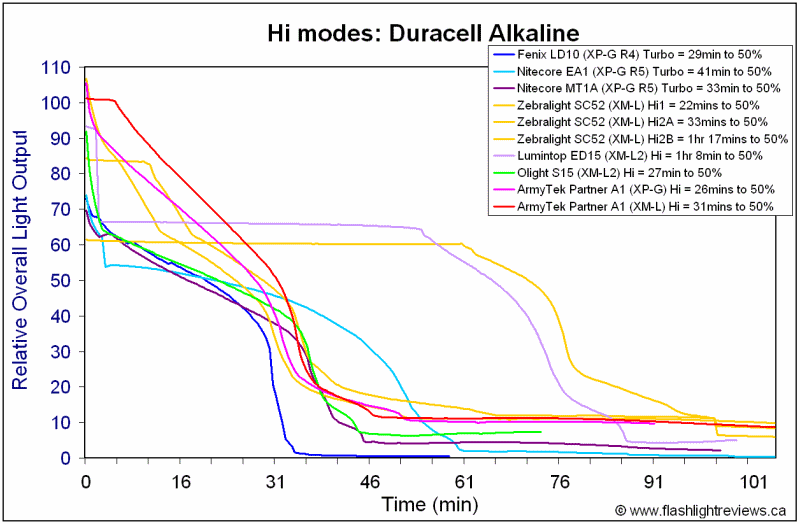

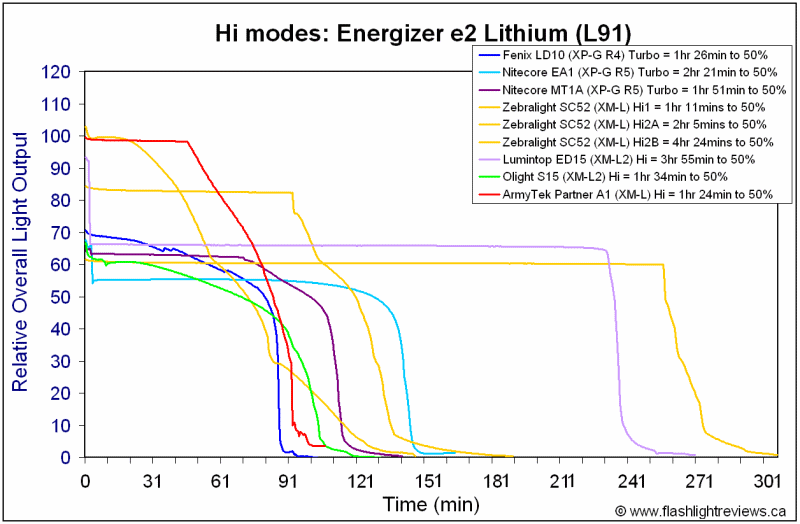
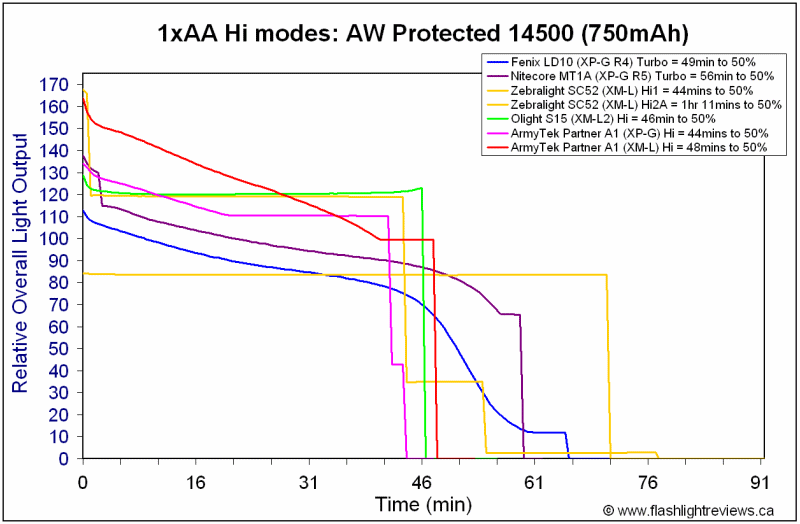
------------
Partner A2
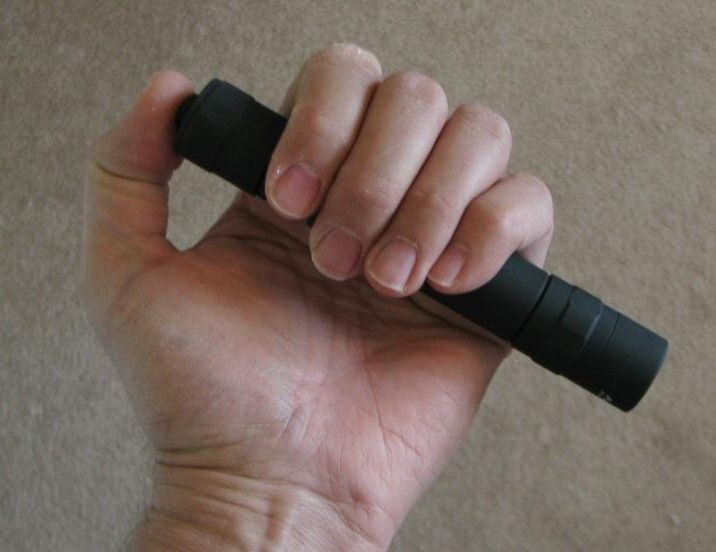
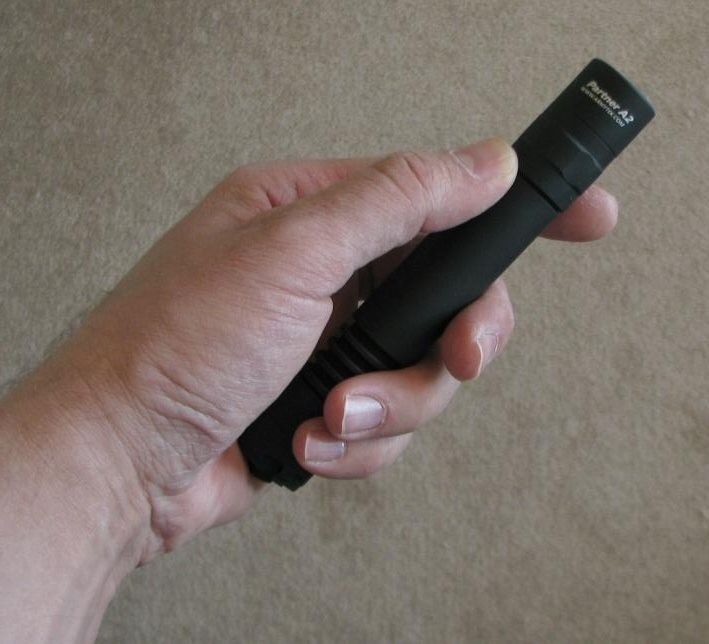
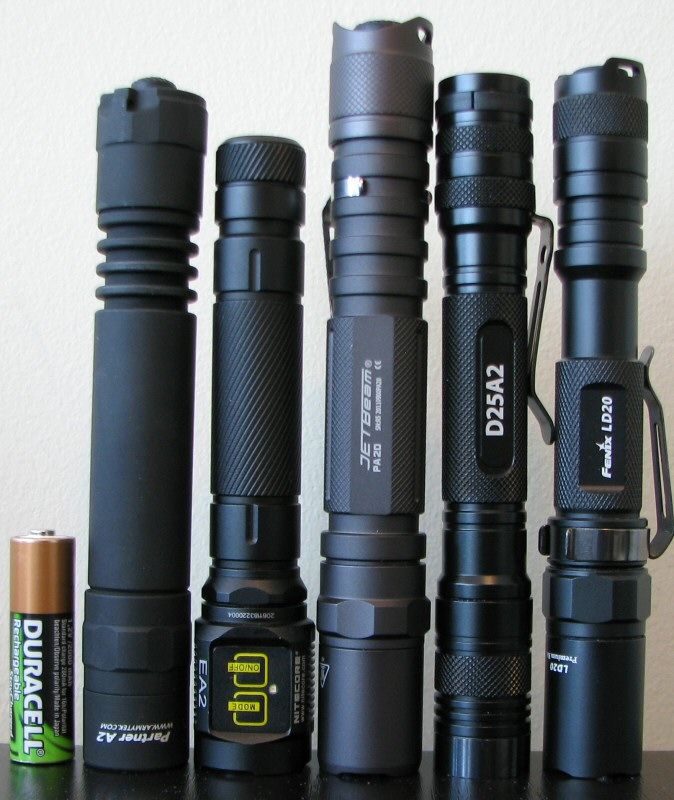
From left to right: Duracell NiMH AA; ArmyTek Partner A2 XP-G; Nitecore EA2; JetBeam PC20; Eagletac D24A2; Fenix LD20-R4.
All dimensions directly measured, and given with no batteries installed:
2xAA:
ArmyTek A2 XP-G: Weight: 83.4g, Length: 96.8mm , With (bezel): 23.2mm
ArmyTek A2 XM-L: Weight: 84.2g, Length: 97.2mm , With (bezel): 23.1mm
Olight S15 2xAA: Weight: 59.2g, Length: 137.9mm, Width (bezel): 23.1mm
Nitecore MT1: Weight: 66.9g, Length: 154.3mm, Width (bezel):22.7mm
Nitecore EA2: Weight: 68.9g, Length: 134.4, Width (bezel): 26.1mm
Eagletac D25A2: Weight: 54.8g, Length 148.5mm, Width (bezel): 21.0mm
4Sevens QAA-2 X (Tactical tailcap): Weight: 60.1g, Length: 149.1mm, Width (bezel) 22.0mm
Jetbeam BA20: Weight: 70.2g, Length: 156.4mm, Width (bezel) 23.2mm
Beamshots:
For white-wall beamshots below, all lights are on Max output on an AW protected 18650 battery. Lights are about ~0.75 meter from a white wall (with the camera ~1.25 meters back from the wall). Automatic white balance on the camera, to minimize tint differences.
Note: the XP-G Partner versions are not labeled with the emitter in the beamshots below. But to help you differentiate, all the XM-L versions are specifically identified.
2xAA Sanyo Eneloop NiMH
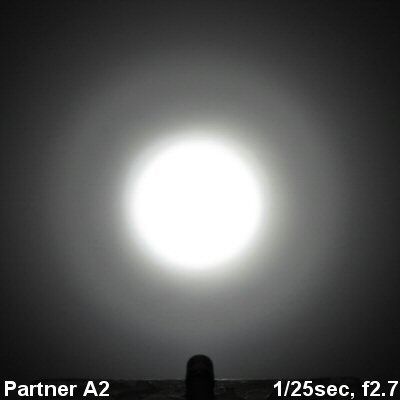
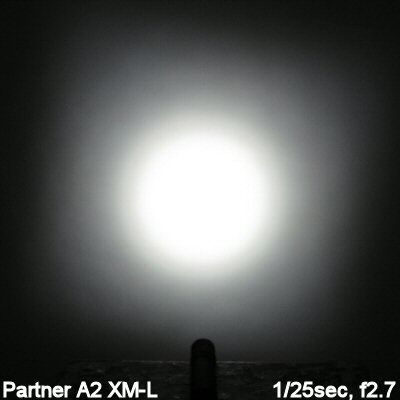
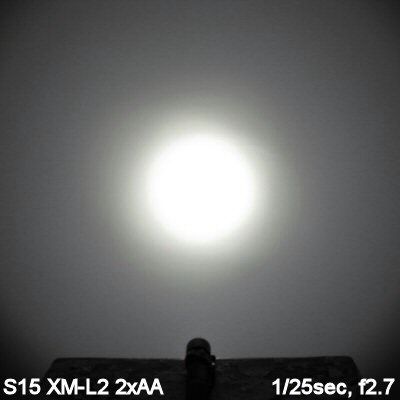
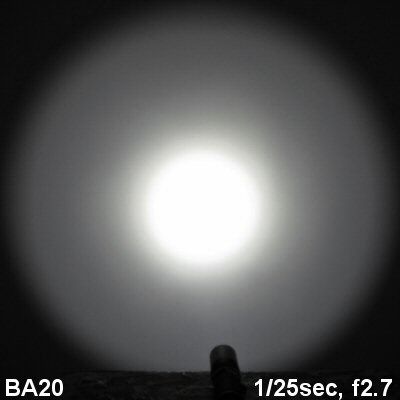
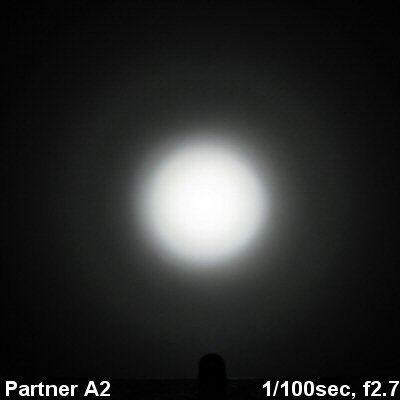

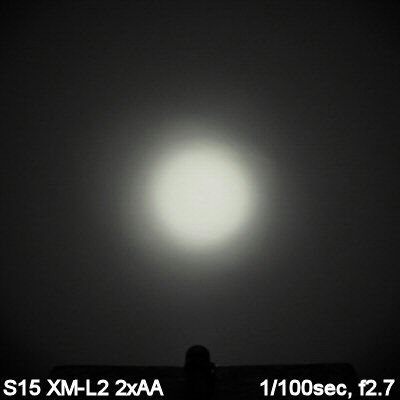
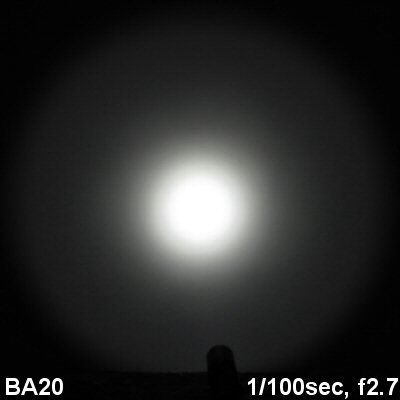
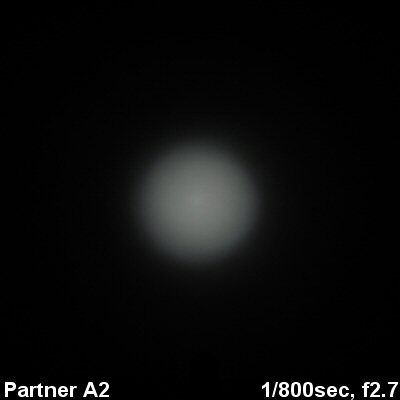
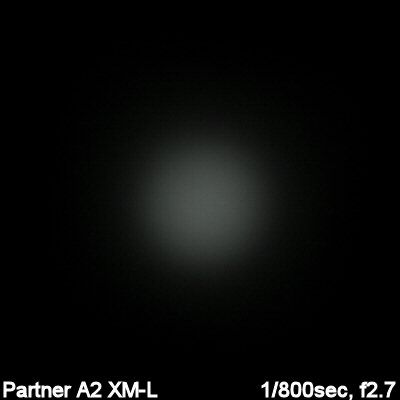
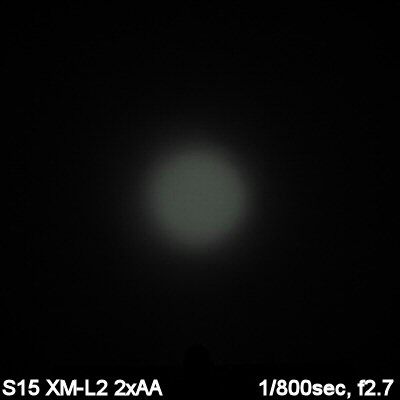
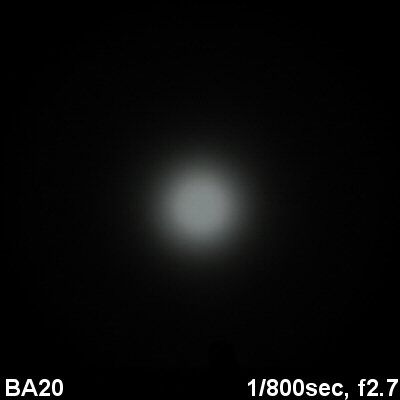
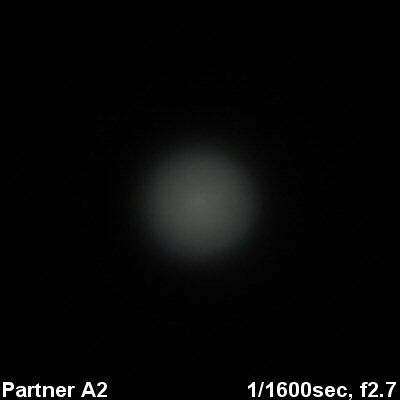
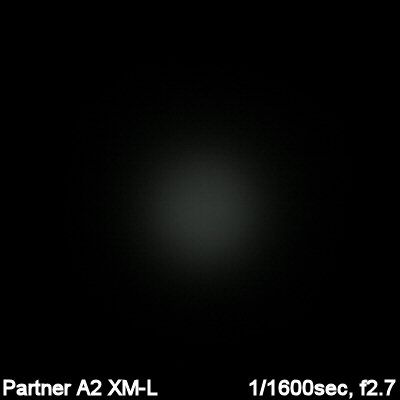
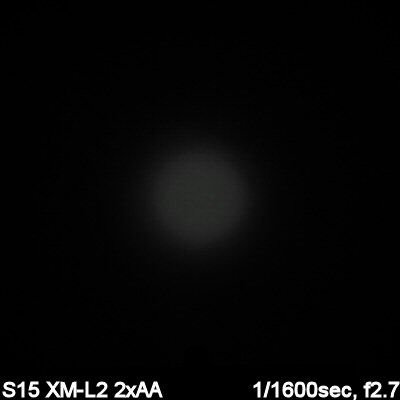
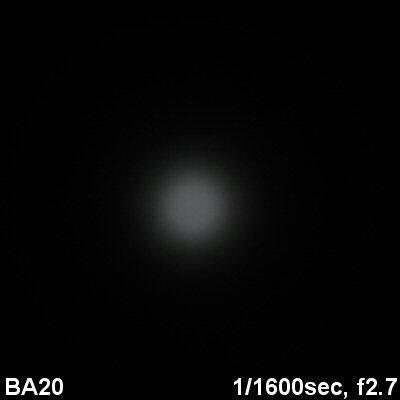
Summary Tables
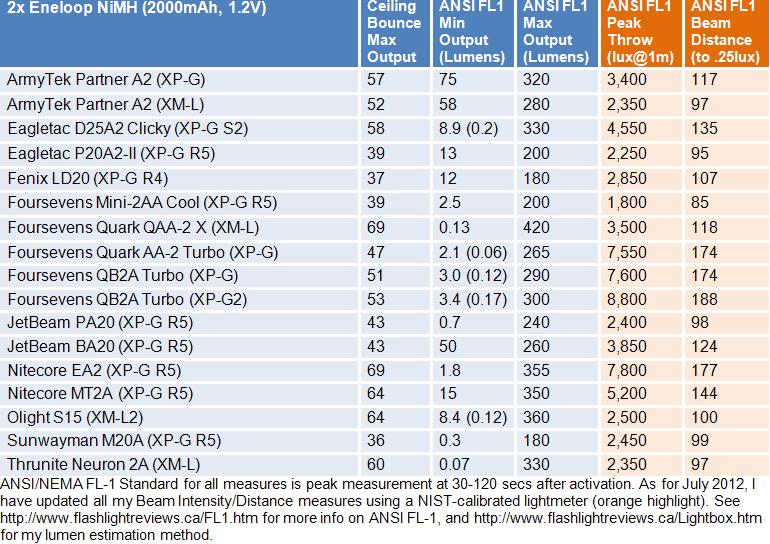
Runtimes
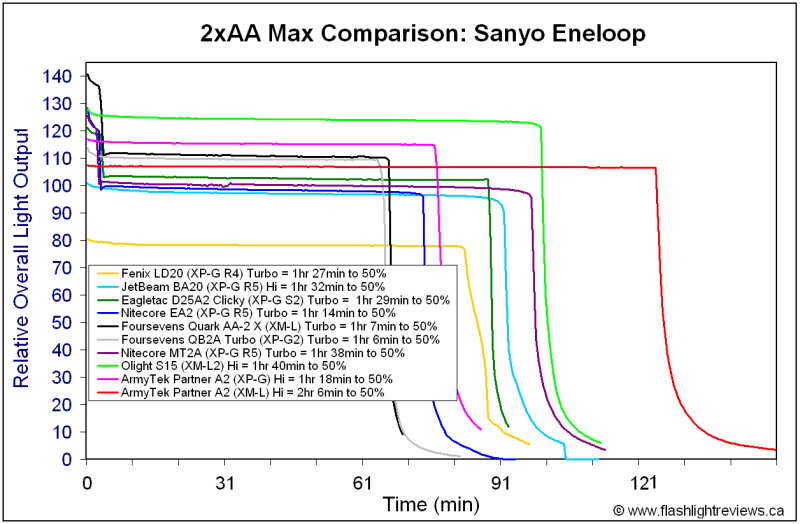
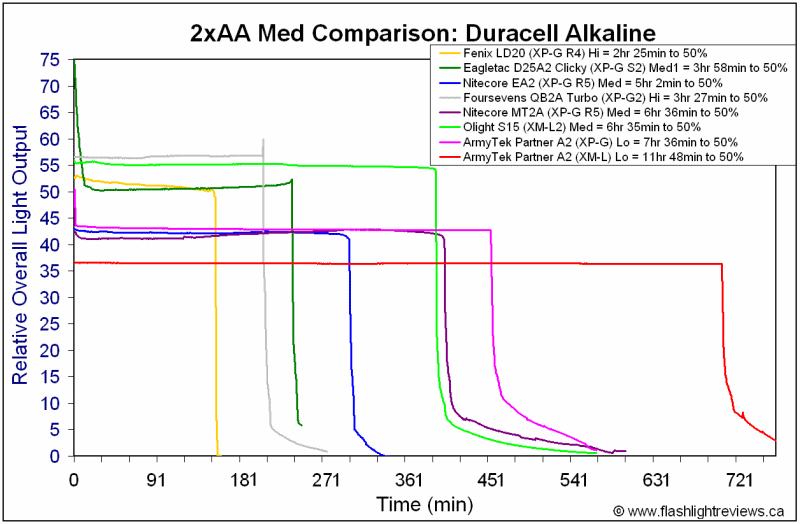
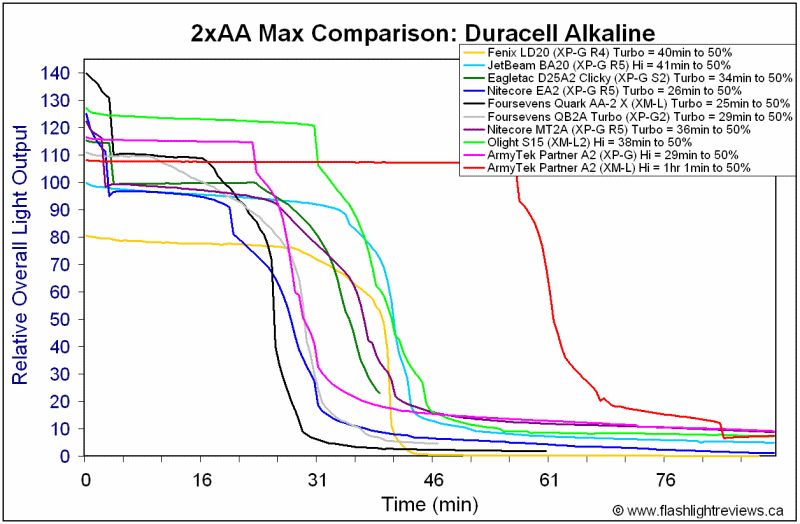
----------------
Potential Issues
The extended retention of the output level state is unusual (i.e., it remembers what the last level used was for up to 7 mins, and will always advance to the next level during this time). This prolonged time is unusual, and I would prefer it if they behaved like most lights (where it is only a few seconds). (see Update at the end of this review)
There are very limited anti-roll features on the light, and no pocket clip is included. (see Update at the end of this review)
Lights lack a true Lo mode (i.e., on standard batteries they are more of a Med/Hi, and on Li-ion batteries more of a Hi/Turbo). (see Update at the end of this review)
Lights use TIR optics, customized to each emitter (i.e., center-beam throw for the XP-G, more diffuse for the XM-L). All optics tend to induce beam artifacts – most notably hotspot artifacts and spillbeam rings on throwers (like the XP-Gs), and "square" beams on floodier lights (like the XM-Ls).
Preliminary Observations
The Partner series is an interesting foray by ArmyTek into the world of simple-to-use, two-stage, basic consumer flashlights.
Let's start with the build – these are among the most solid lights I've seen in the 1xCR123A/AA or 2xAA classes. oo: Build quality is excellent, with good attention to detail (e.g., double o-rings with Nyogel lube, chamfered edges body, flattened tail springs etc.). Physically, they remind me of some of the higher-end made-in-the-USA brands. Simply put, these are tough little lights that I expect would survive a lot of abuse.
oo: Build quality is excellent, with good attention to detail (e.g., double o-rings with Nyogel lube, chamfered edges body, flattened tail springs etc.). Physically, they remind me of some of the higher-end made-in-the-USA brands. Simply put, these are tough little lights that I expect would survive a lot of abuse.
Circuit performance is also top-of-the-line, for their respective emitters and battery classes. No surprises here – both output modes of all models showed excellent regulation and output/runtime efficiency, across all batteries and over both emitters. It took a while for me to complete all the testing for this review (there is a lot of data up there!), and I am impressed to see such consistently good performance.
User interface is perhaps the one sore spot for me – I am really not clear why the mode-switching state memory is 7 mins long. :thinking: Typically, you either want a light to remember its mode indefinitely (and come back to it), or only allow a couple of seconds for mode switching purposes. Given that these are only two-stage lights, it's not a big deal – but it is frustrating to not always be certain which mode will show up upon activation. And personally, I would prefer a head tight/loose mode selection mechanism (with forward clicky for activation), but I know some people prefer to work with only the tailcap switch. :shrug:
The other point that could use a little refinement for me is the level spacing. Right now, the lights all typically offer what I would consider "Med/Hi" levels on standard cells (i.e., no real Lo mode). And on Li-ion, they are basically "Hi/Turbo" (i.e., even brighter, with little visual differentiation between the levels). Again, you are never going to please everyone with just two stages, but I would like to see the "Lo" mode drop further in output (especially on the XP-G versions).
but I would like to see the "Lo" mode drop further in output (especially on the XP-G versions).
Beam patterns are also distinctive for the lines, with the TIR optics instead of reflectors. The XP-G optic is about what I would have expected (i.e., focused for throw, with minimal spill) - throw fans will be happy with this design. The XM-L optic is quite different, with a wider and squarer output beam. Both are well suited to their intended purposes, but differ from you might be used to (if you have dealt predominantly with reflectored lights). Please also keep in mind that the use of optics here may slightly affect the testing results, in terms of the relative output measures (i.e., the lightbox and ceiling bounce numbers may not be exactly comparable to reflectored lights). This is due to differing beam profiles of reflector and optics, which may not be interpreted entirely consistently in my simple setup.
I know this has been a massive review, but hopefully all the detailed testing results above will help you decide if these are lights for you. Whatever your personal preference in this space, I for one am glad to see ArmyTek venture out in the general purpose realm. And I think there is a lot to commend these lights for that purpose, but the two-stage user interface could use some tweaking. :wave:
UPDATE AUGUST 14, 2013: I've heard back from ArmyTek about my recommendations above. They tell me that they opted for a very simple circuit design in their first batch ("without a CPU") which is what led to the large mode-switching delay. They plan to switch to a new circuit without this delay, and will add a third mode (i.e., Max - Med - Lo). They will also include a clip on the next batch of lights. :wave:
----
Partner lights were supplied by ArmyTek for review.
This is a round-up overview of the new Partner family of lights from ArmyTek. All told, I have six different lights in this review – the C1 (1xCR123A/RCR), the A1 (1xAA/14500), and the A2 (2xAA) – in both XP-G and XM-L emitter formats.






Given the complexity of reviewing so many lights at one time, I have broken up this review into common elements up top (i.e., general build, user interface, etc.), and have left the specific comparisons (size overviews, beamshots, runtimes, etc.) in separate sections at the end, for each of the three battery-type models.
For most of this review, I have focused the light pics on the XP-G models, but have highlighted the XM-L versions where appropriate. There's a ton of data here, so sit back and make yourself comfortable …
Manufacturer Reported Specifications:
(note: I don't have space to get into each model in detail, so see ArmyTek's website for more info. Below is just a quick overview of the major features, taken from their website).
- LED: Cree XP-G LED or XM-L LED
- XP-G models TIR 20°:70°, XM-L models TIR 50°:90°
- Small size and weight for easy carry
- 2 Modes and easy operation
- Type of mode switching: Tailcap switch, Reverse clicky
- Advanced heat transmission for LED with copper MPCB
- Special spring material for higher efficiency
- Battery over-discharge protection circuit for unprotected batteries
- Advanced electronic reverse polarity protection
- Light output without flickering
- Ability to use batteries with a flat contact
- Body material: Aircraft-grade aluminium
- Body anti-abrasive finish: Premium type III hard anodizing 400HV
- Premium antislipping matt surface treatment
- Reliable spring construction for battery protection
- Trapezoidal threads for longer lifetime
- Body color: Matt Black
- Waterproof and dustproof standard: IP68 (highest)
- Waterproof & Submersible: 10m
- Double O-rings for best waterproof
- Impact Resistance: 10m
- Belt holster (Molle)
- Strong and easily removable lanyard
- MSRP: ~$40-45



Packaging is common for all versions - a typical carboard box, reminiscent of the Zebralight lights. Inside, the light comes with a basic but good quality holster with closing flap, wrist lanyard, spare o-rings and boot cover, and manual.

From left to right: Rayovac CR123A; ArmyTel Partner C1 XP-G, A1 XP-G, A2 XP-G, Duracell NiMH AA.
Detail comparisons for each model – relative to their respective class – will be provided later in this review.
Common Build Elements




As always, ArmyTek build quality is very high, and the lights have a very robust feel. Physically, the two classes of models are distinguished primarily by their emitters and optics, which I will describe in more detail below.
The ArmyTek finish is fairly unique in my testing - the bodies of their lights have a very thick matte finish anodizing that feels almost molded (i.e., it is very "grippy"). According to ArmyTek, this anodization coating is much thicker than most lights. Although the lights lack knurling, grip is actually quite decent thanks to this unique finish. And there are some ridge detail elements to help further with grip.
Note the grippier finish may show dirt, hand oil, etc, more easily than traditional glossy knurling. There are also no real anti-roll features (except for some flattened areas of the tailcap), so the lights can all roll easily. Lettering is very bright and clear, and very legible.
Screw threads are standard triangular cut, but seem of good quality. Screw threads are anodized at the tail region of the battery tube and in the tailcap (for lock-out). Edges of the battery tube have all been chamfered (i.e., rounded off), which shows a nice attention to detail.
The tailcap switch is a reverse clicky in all lights, with good feel. The spring is thicker and longer than typical on these sorts of lights, with a flattened end (so as not to scratch your batteries).
There is a lanyard attachment point at the base of the tailcap. The lights cannot tailstand.
There is a small raised contact point in the head, so high capacity flat-top batteries can be used.
As mentioned earlier, the lights are distinguished by their emitter and optic choice. Note that the lights do not use a reflector, but have a customized TIR optic that goes with each emitter type.
XP-G emitter:






XM-L emitter:





In all cases, the head of the light has a flat aluminum bezel. Use of TIR optics means the spill will be reduced (compared to reflectored lights). Although hard to capture on camera, please see my detailed beamshots later in this review, for each model.
User Interface
The Partner interface is very basic. The lights use a reverse clicky tailcap – press and release (click) to turn on.
The lights have two modes, Lo and Hi, accessed in sequence (i.e., click off-on to switch modes). When the light hasn't been used in awhile, it always comes on in Lo.
But there is an unusual twist here – when changing between modes, most lights only retain the last setting for a couple of seconds (i.e., you have to click off-on quickly to advance modes). But In the Partner case, mode-switching memory is retained for 7 mins. This means it will advance to the next mode if you turn the light off and back on within 7 mins.
There are no "blinky" modes on the Partners.
UPDATE AUGUST 14, 2013:ArmyTek informs me that they plan to switch to a new circuit without this long mode-switching delay. They will also add a third mode (i.e., Max - Med - Lo), and will include a clip on the next batch of lights.
Video:
For information on the light, including the build and user interface, please see my video overview:
Video was recorded in 720p, but YouTube typically defaults to 360p. Once the video is running, you can click on the configuration settings icon and select the higher 480p to 720p options. You can also run full-screen.
As with all my videos, I recommend you have annotations turned on. I commonly update the commentary with additional information or clarifications before publicly releasing the video.
PWM
There is no sign of PWM at either output level, on any light – the Partners are all current-controlled.
Testing Method:
All my output numbers are relative for my home-made light box setup, a la Quickbeam's flashlightreviews.com method. You can directly compare all my relative output values from different reviews - i.e. an output value of "10" in one graph is the same as "10" in another. All runtimes are done under a cooling fan, except for any extended run Lo/Min modes (i.e. >12 hours) which are done without cooling.
I have devised a method for converting my lightbox relative output values (ROV) to estimated Lumens. See my How to convert Selfbuilt's Lightbox values to Lumens thread for more info.
Throw/Output Summary Chart:
My summary tables are reported in a manner consistent with the ANSI FL-1 standard for flashlight testing. Please see http://www.flashlightreviews.ca/FL1.htm for a discussion, and a description of all the terms used in these tables. Effective July 2012, I have updated all my Peak Intensity/Beam Distance measures with a NIST-certified Extech EA31 lightmeter (orange highlights).
Ok, now that the common elements are out of the way, let's move on to the detailed testing of each battery-type model. :sweat:
------------
Partner C1



From left to right: Rayovac CR123A; ArmyTek Partner C1 XP-G; Foursevens QTLC; Nitecore MT1C; Sunwayman C10Rl JetBeam PC10; Olight S10; Sunwayman V11R.
All dimensions directly measured, and given with no batteries installed:
1xCR123A/RCR:
ArmyTek C1 XP-G: Weight: 42.6g, Length: 79.8mm , With (bezel): 23.1mm
ArmyTek C1 XM-L: Weight: 43.0g, Length: 80.2mm , With (bezel): 23.1mm
Lumintop ED11: Weight: 44.1g, Length: 83.7, Width (bezel): 21.8mm
Foursevens QTLC: Weight 36.4g, Length 84.1mm, Width (bezel) 22.1mm
Olight S10: Weight 41.1g, Length: 70.6mm, Width (bezel): 23.0mm
Sunwayman C10R: Weight: 57.3g, Length: 76.2mm (no lanyard plug), 82.3mm (with plug), Width (bezel): 25.6mm, Width (head at widest part): 28.6mm
Eagletac D25C Clicky: Weight: 30g, Length: 76.0mm, Width (bezel): 20.0mm
Jetbeam PC10: Weight: 50.5g, Length: 93.6mm, Width (bezel): 22.6mm
Beamshots:
For white-wall beamshots below, all lights are on Max output on an AW protected 18650 battery. Lights are about ~0.75 meter from a white wall (with the camera ~1.25 meters back from the wall). Automatic white balance on the camera, to minimize tint differences.
Note: the XP-G Partner versions are not labeled with the emitter in the beamshots below. But to help you differentiate, all the XM-L versions are specifically identified.
1xCR123A
















1xRCR
















Summary Tables


Runtimes




------------
Partner A1



From left to right: Duracell NiMH AA; ArmyTek Partner A1 XP-G; Nitecore MT1A, EA1; Zebralight SC52; Thrunite Neutron 1A; Sunwayman V11R+AA extender.
All dimensions directly measured, and given with no batteries installed:
1xAA:
ArmyTek A1 XP-G: Weight: 57.3g, Length: 96.8mm , With (bezel): 23.1mm
ArmyTek A1 XM-L: Weight: 56.5g, Length: 97.2mm , With (bezel): 23.1mm
Olight S15 1xAA: Weight: 46.4g, Length: 87.0mm, Width (bezel): 23.1mm
Nitecore MT1A: Weight: 54.6g, Length: 104.6mm, Width (bezel): 22.7mm
Nitecore SENS AA: Weight: 26.1g, Length: 82.7mm, Width (bezel): 19.8mm
Lumintop ED15: Weight: 59.7g, Length: 100.2, Width (bezel): 21.9mm
Zebralight SC52: Weight 39.5g, Length 79.0mm, Width (bezel): 22.6mm, Width (max) 25.4mm
Rofis ER12: Wright: 35.5g, Length: 96.2mm, Width (bezel): 18.6mm
Xeno E03:: Weight: 48.1g, Length 96.7mm, Width (bezel): 21.5mm
Beamshots:
For white-wall beamshots below, all lights are on Max output on an AW protected 18650 battery. Lights are about ~0.75 meter from a white wall (with the camera ~1.25 meters back from the wall). Automatic white balance on the camera, to minimize tint differences.
Note: the XP-G Partner versions are not labeled with the emitter in the beamshots below. But to help you differentiate, all the XM-L versions are specifically identified.
1xAA Sanyo Eneloop NiMH
















1x14500 (AW Protected 14500) Li-ion
















Summary Tables


Runtimes





------------
Partner A2



From left to right: Duracell NiMH AA; ArmyTek Partner A2 XP-G; Nitecore EA2; JetBeam PC20; Eagletac D24A2; Fenix LD20-R4.
All dimensions directly measured, and given with no batteries installed:
2xAA:
ArmyTek A2 XP-G: Weight: 83.4g, Length: 96.8mm , With (bezel): 23.2mm
ArmyTek A2 XM-L: Weight: 84.2g, Length: 97.2mm , With (bezel): 23.1mm
Olight S15 2xAA: Weight: 59.2g, Length: 137.9mm, Width (bezel): 23.1mm
Nitecore MT1: Weight: 66.9g, Length: 154.3mm, Width (bezel):22.7mm
Nitecore EA2: Weight: 68.9g, Length: 134.4, Width (bezel): 26.1mm
Eagletac D25A2: Weight: 54.8g, Length 148.5mm, Width (bezel): 21.0mm
4Sevens QAA-2 X (Tactical tailcap): Weight: 60.1g, Length: 149.1mm, Width (bezel) 22.0mm
Jetbeam BA20: Weight: 70.2g, Length: 156.4mm, Width (bezel) 23.2mm
Beamshots:
For white-wall beamshots below, all lights are on Max output on an AW protected 18650 battery. Lights are about ~0.75 meter from a white wall (with the camera ~1.25 meters back from the wall). Automatic white balance on the camera, to minimize tint differences.
Note: the XP-G Partner versions are not labeled with the emitter in the beamshots below. But to help you differentiate, all the XM-L versions are specifically identified.
2xAA Sanyo Eneloop NiMH
















Summary Tables

Runtimes



----------------
Potential Issues
The extended retention of the output level state is unusual (i.e., it remembers what the last level used was for up to 7 mins, and will always advance to the next level during this time). This prolonged time is unusual, and I would prefer it if they behaved like most lights (where it is only a few seconds). (see Update at the end of this review)
There are very limited anti-roll features on the light, and no pocket clip is included. (see Update at the end of this review)
Lights lack a true Lo mode (i.e., on standard batteries they are more of a Med/Hi, and on Li-ion batteries more of a Hi/Turbo). (see Update at the end of this review)
Lights use TIR optics, customized to each emitter (i.e., center-beam throw for the XP-G, more diffuse for the XM-L). All optics tend to induce beam artifacts – most notably hotspot artifacts and spillbeam rings on throwers (like the XP-Gs), and "square" beams on floodier lights (like the XM-Ls).
Preliminary Observations
The Partner series is an interesting foray by ArmyTek into the world of simple-to-use, two-stage, basic consumer flashlights.
Let's start with the build – these are among the most solid lights I've seen in the 1xCR123A/AA or 2xAA classes.
Circuit performance is also top-of-the-line, for their respective emitters and battery classes. No surprises here – both output modes of all models showed excellent regulation and output/runtime efficiency, across all batteries and over both emitters. It took a while for me to complete all the testing for this review (there is a lot of data up there!), and I am impressed to see such consistently good performance.
User interface is perhaps the one sore spot for me – I am really not clear why the mode-switching state memory is 7 mins long. :thinking: Typically, you either want a light to remember its mode indefinitely (and come back to it), or only allow a couple of seconds for mode switching purposes. Given that these are only two-stage lights, it's not a big deal – but it is frustrating to not always be certain which mode will show up upon activation. And personally, I would prefer a head tight/loose mode selection mechanism (with forward clicky for activation), but I know some people prefer to work with only the tailcap switch. :shrug:
The other point that could use a little refinement for me is the level spacing. Right now, the lights all typically offer what I would consider "Med/Hi" levels on standard cells (i.e., no real Lo mode). And on Li-ion, they are basically "Hi/Turbo" (i.e., even brighter, with little visual differentiation between the levels). Again, you are never going to please everyone with just two stages,
Beam patterns are also distinctive for the lines, with the TIR optics instead of reflectors. The XP-G optic is about what I would have expected (i.e., focused for throw, with minimal spill) - throw fans will be happy with this design. The XM-L optic is quite different, with a wider and squarer output beam. Both are well suited to their intended purposes, but differ from you might be used to (if you have dealt predominantly with reflectored lights). Please also keep in mind that the use of optics here may slightly affect the testing results, in terms of the relative output measures (i.e., the lightbox and ceiling bounce numbers may not be exactly comparable to reflectored lights). This is due to differing beam profiles of reflector and optics, which may not be interpreted entirely consistently in my simple setup.
I know this has been a massive review, but hopefully all the detailed testing results above will help you decide if these are lights for you. Whatever your personal preference in this space, I for one am glad to see ArmyTek venture out in the general purpose realm. And I think there is a lot to commend these lights for that purpose, but the two-stage user interface could use some tweaking. :wave:
UPDATE AUGUST 14, 2013: I've heard back from ArmyTek about my recommendations above. They tell me that they opted for a very simple circuit design in their first batch ("without a CPU") which is what led to the large mode-switching delay. They plan to switch to a new circuit without this delay, and will add a third mode (i.e., Max - Med - Lo). They will also include a clip on the next batch of lights. :wave:
----
Partner lights were supplied by ArmyTek for review.
Last edited:

